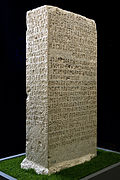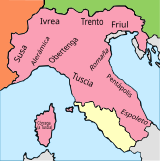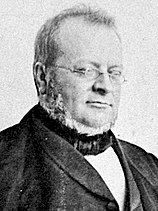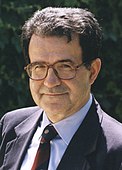Mbili ya Italy
| Mbiri ya Italy |
|---|
 |
| Lua error: bad argument #2 to 'title.new' (unrecognized namespace name 'Portal'). |
| Part of a series on the |
| Chikhalidwe cha Italy |
|---|
 |
| Ŵanthu |
| Kuphika |
| Viphikiro |
| Kucita vinthu vya luso |
| Mabuku |
Ŵanthu ŵakukhala mu caru ca Italy ico cili ku Europe kwa vilimika pafupifupi 850,000 ivyo vyajumpha. Kwambira kale chomene, ŵanthu ŵa ku Italy ŵakakhalanga mu chigaŵa ichi. Kale, caru ca Italy cikaŵa cikaya ca Ŵaroma ndiposo msumba ukuru wa vigaŵa vya Ufumu wa Roma.[1][2] Ufumu wa Romu ukaŵako mu 753 B.C.E. ndipo ukazgoka charu cha Romu mu 509 B.C.E., apo ufumu wa Romu ukathereskeka. Kufuma apo, boma la Romu likasazga Italy na ŵanthu ŵa ku Etruria, Celt, na Greece awo ŵakakhalanga mu chigaŵa ichi. Ŵaroma ŵakalongozganga Socii, gulu la ŵanthu ŵakuyowoya Chiitaliki, ndipo pamasinda, Ŵaroma ŵakamba kulamulira ku Western Europe, North Africa, na Near East.
Ufumu wa Roma ukamara apo Julius Caesar wakakomeka. Ufumu wa Roma ndiwo ukalongozga vyaru vya kumanjiliro gha dazi kwa Europe na Mediterranean kwa vyaka vinandi, ndipo ukawovwira chomene kuti ŵanthu ŵa kumanjiliro gha dazi ŵasambire vinjeru, sayansi, na luso. Pamanyuma pakuti Roma wabwangandulika mu 476 C.E., Italy yikagaŵikana mu vigaŵa vinandi, m'paka mu 1871 apo charu chikaŵa pamoza. Vyaru vya ku nyanja, comenecomene Venice na Genoa, vikaŵa na cuma cikuru comene cifukwa ca ulendo wa pa nyanja, malonda, na mabanki.[3][4] Chigaŵa chapakati cha Italy chikalutilira kulamulirika na Ŵapapa, apo chigaŵa cha kumwera kwa Italy chikalutilira kulamulirika na ŵasilikari ŵa Byzantine, Arab, Norman, Spanish, na Bourbon.[5][6] Nyengo ya kuwelera ku Italy yikathandazgikira mu vyaru vinyake vya ku Europe, ndipo ŵanthu ŵakamba kutemwa chomene vya ŵanthu, sayansi, kusanda vinthu, na luso. Ŵalendo ŵa ku Italy (mwakuyana na Marco Polo, Christopher Columbus, na Amerigo Vespucci) ŵakasanga nthowa ziphya zakulutira ku Far East na ku New World, ndipo ŵakambiska nyengo ya Discovery. Mu vyaka vinandi ivyo vyajumpha, caru ca Italy cikaŵa na ŵanthu ŵanandi comene nga ni Dante Alighieri, Leonardo da Vinci, Michelangelo, Niccolò Machiavelli, Galileo Galilei na Raphael.
Pakati pa vyaka vya m'ma 1800, Giuseppe Garibaldi wakawovwira kuti Italy wakolerane na ufumu wa Sardinia. Ufumu uphya wa Italy, uwo ukakhazikiskika mu 1861, ukasintha vinthu mwaluŵiro na kuzenga ufumu wa vyaru vinyake. Pa nyengo yeneyiyo pera, kumwera kwa Italy kukaŵa ku mizi ndipo kukaŵa ukavu. Mu Nkhondo Yakwamba ya Caru Cose, Italy wakamalizga kuwungana mwa kupoka Trento na Trieste, ndipo wakapokera mpando wakukhalilira mu wupu wa League of Nations. Ŵanthu ŵa ku Italy ŵakawonanga kuti Nkhondo Yakwamba ya Caru Cose njawakawaka cifukwa cakuti caru ca Italy cikaŵa na vigaŵa vyose yayi ivyo vikalayizgika na phangano la ku London (1915). Nkhondo Yachiŵiri ya Caru Cose yikati yacitika pamoza na Nazi Germany na Ufumu wa Japan, ŵasilikari ŵakathereskeka, Mussolini wakakakika na kucimbira, ndipo nkhondo ya mukati mu Italy yikamba.
Pamanyuma pakuti Italy wafwatuka, Social Republic wawa, ndipo Benito Mussolini wakomeka na gulu la Resistance, mu 1946 ŵanthu ŵakakanizga boma la Italy kuti liŵe lacifumu, ndipo likazgoka republiki. Chikulutilira kuŵa na nkhongono pa nkhani ya vya cuma, mitheto, nkhondo, na ndyali mu vilimika vya m'ma 2000.[7][8]
Mbili yakwambilila

Ŵanthu ŵakwambilira ŵakafika ku Monte Poggiolo vyaka 850,000 ivyo vyajumpha. Ŵanthu ŵa ku Neanderthal ŵali kusangika ku malo agho ghakusangika kufupi na Roma na Verona vyaka pafupifupi 50,000 ivyo vyajumpha. Ŵanthu ŵakwambilira awo ŵakaŵako mu nyengo ya Paleolithiki ŵakaŵa ŵanthu ŵakwambilira awo ŵakaŵako vyaka 48,000 ivyo vyajumpha. Mu Novembala 2011, ku Oxford Radiocarbon Accelerator Unit ku England, ŵakachita kafukufuku pa ivyo ŵanthu ŵakaghanaghananga kuti ni mino gha mwana wa munthu wa ku Neanderthal. Vinthu ivyo vikakhalapo mu nyengo ya ŵanthu awo ŵakaŵako kale vikusangika mu Lombardy (malibwe agho ghakaŵa mu msumba wa Valcamonica) na mu Sardinia (nuraghe). Cinyake ico cikumanyikwa comene ni ca Ötzi the Iceman, cikozgo ca munthu uyo wakacimbiranga nyama mu mapiri ico cikasangika mu Similaun glacier ku South Tyrol, ca m'ma c. 3400-3100 B.C.E.[9]
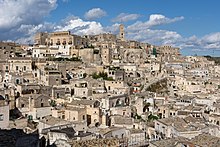
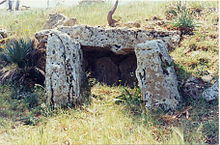
Mu nyengo ya mkuwa, ŵanthu ŵa ku Indo-Europe ŵakaluta ku Italy. Ŵanthu aŵa ŵakwiza mu vigaŵa pafupifupi vinayi kufuma kumpoto m'paka ku Alps. Ŵanthu ŵakwamba kufuma ku Indo-Europe ŵakaluta ku malo ghanyake m'ma 2000 B.C.E., kufuma ku ŵanthu awo ŵakizanga na vinthu vya mkuwa. Ŵanthu ŵa ku Remedello ndiwo ŵakamba kulamulira chigaŵa cha Po. Ŵanthu ŵanandi ŵakasamukira ku malo agha mu nyengo ya Bronze, kwamba m'ma 2000 C.E. m'paka m'ma 2000 C.E. Ŵanthu aŵa ŵakakhalanga mu chigaŵa cha Padan Plain, Tuscany, na mumphepete mwa nyanja za Sardinia na Sicily.
Pakati pa vyaka vya m'ma 2000 B.C.E., kukaŵa chimphepo chachitatu icho chikamba kwiza, icho chikakolerana na ŵanthu ŵa ku Apennine na ŵanthu ŵa ku Terramare. Ivyo ŵanthu ŵa ku Terramare ŵakachitanga pakuyaniska na ivyo ŵakachitanga mu nyengo ya Neolithic vingawoneka kuti vikaŵa vyaunenesko. Ŵakaŵa ŵachali ŵalovi, kweni ŵakaŵa na viŵeto vyakukhora. Ŵakaŵa ŵaluso comene pakupanga visulo, ŵakapanganga mkuŵa mu malibwe na dongo. Kweniso ŵakaŵa ŵalimi, ŵakaliskanga mphoza, mpheska, tirigu, na linoni.[11]

Mu nyengo ya Bronze, kufuma kuumaliro wa vyaka vya m'ma 2000 m'paka kuuyambiro wa vyaka vya m'ma 2000 B.C.E., ŵanthu ŵakamba kugwiliskira ntchito visulo mu Italy. Chikhalidwe cha Proto-Villanova chinali mbali ya chikhalidwe cha Urnfield cha ku Ulaya. Vinthu ivi vikuyana waka na vigaŵa vya Bavaria-Upper Austria na Middle-Danube. Kweni ŵanyake ŵakughanaghana kuti chikafuma ku ŵanthu ŵa ku Terramare awo ŵakakhalanga mu Dambo la Po. Ŵanthu ŵanyake nga ni Marija Gimbutas, ŵakayaniska mitheto iyi na umo ŵanthu ŵa ku Italy ŵakafikira mu caru ici. Ku Sicily, ŵasanga tumalundi tunyake twa m'ma 2000 B.C.E., uto tukuyana waka na uto tikusanga ku Spain, Balearic Islands, Sardinia, na Apulia. Munthu uyo wakabowozga cikaya ici (uyo wakacicema mu Sicily kuti "Dolmens Culture") wakayaniska cikaya ici na nyengo iyo cikaya ici cikizira ku Sicily.[12]
Nuragic civilization

Ŵanthu ŵa mtundu wa Nuraghe ŵakababikira ku Sardinia na kumwera kwa Corsica. Zina lawo likufuma ku vigongwe vya Nuragic, ivyo vikapangika kufuma ku vikumba vya megalithic ivyo vikazengeka kale. Mazuŵa ghano, ku Sardinia kuli nyumba zakuzengeka na ŵanthu ŵakujumpha 7,000.
Palije maukaboni agho ghakulongora kuti ŵanthu aŵa ŵakaŵako kale, padera pa maukaboni ghachoko waka agho ghakalembeka mu nyengo ya Nuragic. Nkhani izo zili kulembeka zikufuma ku mabuku gha Ŵagiriki na Ŵaroma, ndipo zikuwoneka nga ni nthano.
Chiyowoyero icho ŵanthu ŵakayowoyanga ku Sardinia mu nyengo ya Bronze chikumanyikwa yayi chifukwa palije malemba gha nyengo iyi, nangauli kafukufuku uyo wachitika sonosono apa wakulongora kuti ŵanthu ŵa mtundu wa Nuragic ŵakagwiliskiranga ntchito alifabeti yakuyana na iyo ŵakagwiliskiranga ntchito ku Euboea.
Eduardo Blasco Ferrer wakati chiyowoyero cha Paleo-Sardinian chikaŵa chakuyana waka na chiyowoyero cha Proto-Basque na Chiiberiya chakale. Ŵasayansi ŵanyake ŵakughanaghana kuti mu Nuragic Sardinia mukaŵa vigaŵa viŵiri panji kujumpha apa.[13]:241–254
-
Monte d'Accoddi, 4th millennium BCE.
-
Bronze sculpture of a Nuragic chief from Uta.
Iron Age
Mu vyaka vya m'ma 700 B.C.E., ŵanthu ŵakamba kulemba vilembo vya Chifenike.
Etruscan civilization

Ŵanthu ŵa ku Etruscan ŵakamba kukhala mu chigaŵa chapakati cha Italy mu 800 B.C.E. Ŵanthu ŵa ku Etruria ŵakamba kumanyikwa mu nyengo yakale. Ŵanthu ŵanandi ŵakugomezga kuti ŵanthu aŵa ŵakafuma ku Villanova. Kafukufuku wakukhwaskana na DNA ya mitochondrial uyo wakachitika mu 2013, wakulongora kuti ŵanthu ŵa ku Etruscan ndiwo ŵakakhalanga ku malo agha.
Ŵanthu ŵanandi ŵakugomezga kuti ŵanthu ŵa ku Etruscan ŵakayowoyanga chiyowoyero chinyake. Vinthu vinyake ivyo vili kulembeka mu ciyowoyero ici vyazunulika pa cirwa ca Lemnos mu nyanja ya Aegean. Ŵanthu ŵa ku Etruria ŵakagonanga ŵekha. Ŵanthu ŵa ku Etruria ŵakaŵa na boma ilo likaŵa na visambizgo vya ŵalongozgi ŵa mafuko. Chisopa cha Etruscan chikaŵa cha ŵanthu ŵanandi awo ŵakasopanga ŵachiuta ŵatesi, ndipo vinthu vyose ivyo vikuwoneka ŵakaviwonanga kuti ni nkhongono za Chiuta.

Ŵanthu ŵa ku Etruscan ŵakamba kuthandazgika chomene mu mapiri gha Apenine. Mu vyaka vya m'ma 500 B.C.E., matawuni ghanyake ghachoko waka ghakazimwa. Ndipouli, palije kukayika kuti ndyali za ku Etruscan zikayananga na za ku Magna Graecia kumwera. Ŵanthu ŵa ku Etruria ŵakasambazga comene cifukwa ca kunozga na kuguliska visulo, comenecomene mkuŵa na cisulo. Pa nyengo iyi, Ŵagiriki ŵakasuzgikanga chomene na ŵanthu ŵa ku Greece, comenecomene mu vyaka vya m'ma 500 B.C.E., apo ŵanthu ŵa ku Phocean ku Italy ŵakakhazikiskanga vikaya mumphepete mwa nyanja za France, Catalonia, na Corsica. Ici cikapangiska kuti ŵa Etruscans ŵanjire mu mtende na ŵa Carthage, awo ŵakasuskananga na Ŵagiriki.[14][15]
Mu 540 B.C.E., Nkhondo ya ku Alalia yikapangiska kuti mazaza gha ŵanthu ghagaŵikane mu vigaŵa vya kumanjiliro gha dazi kwa Nyanja ya Meditereniyani. Nangauli nkhondo iyi yikaŵavya uyo wakathereskeka, kweni Carthage wakalutilira kuthandazga ufumu wake pa Ŵagiriki. Kwambira mu hafu yakwamba ya 5 C.E., vinthu vikasintha pa charu chose. Mu 480 B.C.E., Carthage uyo wakaŵa mubwezi wa Etruria, wakathereskeka na ŵasilikari ŵa Magna Graecia awo ŵakalongozgekanga na Syracuse.
Pakati pajumpha vyaka vichoko waka, mu 474 B.C.E., Hiero, fumu yankhongono ya ku Syracuse, yikatonda Ŵaetruska pa Nkhondo ya Cumae. Nkhongono ya Etruria pa misumba ya Latium na Campania yikamba kucepa, ndipo yikaŵa mu mawoko gha Ŵaroma na ŵa Samnites. Mu vyaka vya m'ma 300 C.E., ŵanthu ŵa ku Gallic ŵakiza ku Etruria kuti ŵathereske ŵanthu ŵa mu dambo la Po na mumphepete mwa nyanja ya Adriatic. Pa nyengo iyi, Ŵaroma ŵakamba kupoka misumba ya ku Etruria. Ici cikapangiska kuti ŵaleke kukhala mu vigaŵa vya kumpoto. Mu 500 B.C.E., charu cha Etruria chikapokeka na Ŵaroma.[14][15]
Italic peoples
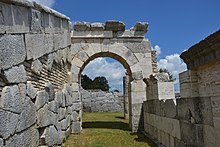

Ŵanthu awo ŵakayowoyanga Chiitaliki ŵakaŵa ŵanthu ŵa viyowoyero vyakupambanapambana. Ŵanthu awo ŵakayowoyanga Chiitaliki ŵakaŵa Osci, Veneti, Samnites, Latins, na Umbri.
Ku chigaŵa cha kumwera kwa Tiber (Latium Vetus), ŵanthu ŵa ku Latin ŵakamba kukhala ku Latial, ndipo kumpoto kwa chigaŵa ichi, ŵanthu ŵa ku Veneti ŵakamba kukhala ku Este. Mu nyengo yeneyiyi, kufuma ku chigaŵa chawo chapakati ku Italy (mu chigaŵa cha Umbria na Sabina mazuŵa ghano), ŵanthu ŵa ku Osco-Umbria ŵakamba kusama mu vigaŵa vyakupambanapambana, kwizira mu ndondomeko ya Ver sacrum, kusazgirako vyaru vinyake, kumwera kwa Latium, Molise na hafu yose ya kumwera kwa chirwa ichi. Ivi vikukolerana na umo ŵanthu ŵa ku Terni ŵakaŵirako, awo ŵakaŵa ŵakuyana chomene na ŵanthu ŵa ku Hallstatt na La Tène. Malo ghakusungirako ŵakufwa gha ku Umbria ku Terni, agho ghakaŵako mu vyaka vya m'ma 1000 B.C.E., ghakaŵa ghakuyana waka na malo ghakusungirako ŵakufwa gha ku Golasecca.
Pambere Ŵagiriki na Ŵafoinike ŵandafike, ŵanthu ŵa ku Sicily ŵakakhalanga kale pa chirwa ichi. Ŵanthu ŵa ku Sicily ndiwo ŵakambiska zina lakuti Sicily.
Ŵanthu awo ŵakakhalanga kumpoto kwa Italy mu nyengo ya chisulo ŵakaŵa ŵa Ligure. Ŵanthu ŵanandi ŵakugomezga kuti cha m'ma 2000 B.C.E., ŵanthu aŵa ŵakakhalanga mu chigaŵa chikuru cha Italy, kusazgapo chigaŵa chikuru cha kumpoto cha Italy na chigaŵa chose cha Tuscany (chigaŵa icho chili kumpoto kwa mlonga wa Arno). Pakuti ŵanthu ŵanandi ŵakuwona kuti chiyowoyero cha ŵanthu aŵa chikafuma mu nyengo ya Indo-Europe, kanandi ŵakuchiwona kuti ntcha ku malo yayi.
Kuzakafika pakati pa vyaka vya m'ma 1000 B.C.E., ŵanthu ŵa ku Roma ŵakamba kuŵa na nkhongono. Ŵanthu ŵa ku Latin ŵakati ŵajiwombora ku wuzga wa Etruscan, ŵakamba kulamulira mafuko gha ku Italy. Kufuma apo, pakaŵaso nkhondo pakati pa mafuko gha ŵanthu ŵa ku Italy. Nkhondo izo zikalembeka makora comene ni izo zikacitika pakati pa Ŵalatini na Ŵasameni.[16]
Paumaliro, ŵanthu ŵa ku Latin ŵakakolerana na ŵanthu ŵa ku Italy. Ŵanthu ŵanandi awo ŵakasambiranga Chilatini yayi ŵakamba kusambira Chilatini ndipo ŵakazgoka Ŵaroma. Kukwambilira kwa vyaka vya m'ma 100 B.C.E., mafuko ghanandi gha ku Italy, chomenechomene Marsi na Samnites, ghakagalukira Ŵaroma. Nkhondo iyi yikumanyikwa kuti Nkhondo ya pa Caru. Ŵaroma ŵakati ŵathereska Ŵaroma, ŵanthu wose ŵa ku Italy ŵakapika wanangwa wa kuŵa ŵenekaya ŵa caru ca Roma, kupaturako Ŵacelt ŵa mu Dambo la Po. Mu vyaka vyakulondezgapo, ŵanthu ŵa mu mafuko gha Chilatini ŵakamba kuyowoya Chilatini.[16]
Magna Graecia
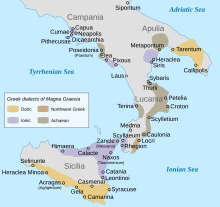
Mu vyaka vya m'ma 800 na 700 B.C.E., ŵanthu ŵa ku Greece ŵakamba kukhala ku Southern Italy chifukwa cha masuzgo gha ŵanthu (njara, unandi wa ŵanthu, na vinyake). 14–18). Kweniso mu nyengo iyi, Ŵagiriki ŵakakhazikiskanga vikaya vyawo ku malo agho ghakaŵa kutali chomene nga ni kumafumiro gha dazi kwa Nyanja Yiswesi, kumafumiro gha dazi kwa Libya, na Massalia (Marseille) ku Gaul. Ŵakaŵa na ŵanthu ŵa ku Sicily na kumwera kwa Italy.
Ŵaroma ŵakacemanga cigaŵa ca Sicily na Italy kuti Magna Graecia (Cilatini, "Greece Mukuru"), cifukwa cikaŵa na ŵanthu ŵanandi ŵa ku Greece. Ŵanthu awo ŵakasanda malo ŵakale ŵakakolerananga yayi pa nkhani yakuti lizgu ili likung'anamura Sicily panji Apulia, Campania na Calabria.
Cifukwa ca ukoloni uwu, cikaya ca Cigiriki cikatolekera ku Italy, mu viyowoyero vya Cigiriki, maluso gha cisopa, na mitheto ya boma lakujiyimira. Nyengo yichoko waka, ŵanthu ŵa ku Greece ŵakamba kukhala ku malo agha. Chiyowoyero chakuzirwa chomene chikaŵa cha Chigiriki cha Chalcidean/Cumaean, icho chikalembeka na ŵanthu ŵa ku Etruscan.

Misumba yinandi ya ku Greece yikaŵa yisambazi kweniso yankhongono, nga ni Neapolis (Νεάπολις, Naples, "Msumba Uphya"), Syracuse, Acragas, na Sybaris (Σύβαρις). Matawuni ghanyake gha ku Magna Graecia ghakaŵa Tarentum (Τάρας), Epizephyrian Locri (Λοκροί) Rhegium, Croton, Thurii, Elea, Nola, Ancona, Syessa, Bari, na ghanyake.
Pyrrhus wa ku Epirus wakati watondeka kulekeska ufumu wa Ŵaroma mu 282 B.C.E., kumwera kwa charu ichi kukaŵa pasi pa Ŵaroma ndipo ŵakalutilira kuwukira Ŵaroma. Ufumu wa Byzantium ndiwo ukawusanga pamanyuma pakuti Romu wawira kumanjiliro gha dazi ndipo nanga ni ŵa Lombard ŵakatondeka kuwukhozga, nangauli msumba wa kumwera ukaŵa wawo kufuma apo Zotto wakawusanga mu cigaŵa caumaliro ca vyaka vya m'ma 400 C.E..
Roman period
Roman Kingdom
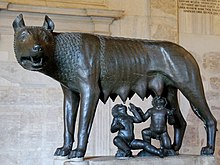
Ŵanthu ŵanandi ŵakumanya vinandi yayi vyakukhwaskana na Ufumu wa Roma, chifukwa palije mabuku agho ghakalembeka pa nyengo iyo. Ndipouli, mdauko wa Ufumu wa Roma ukamba na kukhazikiskika kwa msumba uwu, uwo ukambira mu 753 B.C.E. ndipo ukaŵa na ŵanthu awo ŵakakhalanga pa Phiri la Palatine mumphepete mwa Mlonga wa Tiber ku Italy.
Pa malo agha pakaŵa msewu unyake uwo ŵanthu ŵakambukiranga Mlonga wa Tiber. Phiri la Palatine na tumapiri tunyake uto tukazingilizga phiri ili, vikaŵa vyambura kusuzga kuvikilira. Vinthu vyose ivi vikawovwira kuti msumba uwu ukure makora.
Ŵanthu ŵanandi ŵakugomezga kuti mu vyaka vya m'ma 100 C.E., mu ufumu wa Romu mukaŵa mafumu 7. Ŵakaŵa na vyaka 243 pa nyengo iyo ŵakalamuliranga, ndipo kufuma waka apo Barthold Georg Niebuhr wakalemberanga Baibolo, ŵanthu ŵanandi ŵakuŵamanya yayi.

Ŵagali ŵakaparanya vinthu vinandi ivyo vikalembeka mu mbiri ya Roma apo ŵakapoka msumba uwu mu 390 B.C.E. (Varronian, kuyana na Polybius nkhondo iyi yikachitika mu 387/6) ndipo ivyo vikakhalako vikamara mu nyengo panji kwiba. Pakuti palije ukaboni wakuti ufumu uwu ukaŵako mu nyengo yira, tikwenera kusanda mwakupwelelera nkhani zose za mafumu agha.
Kuyana na nthano ya Roma, msumba uwu ukazengeka pa Epulero 21, 753 B.C.E. na ŵabali ŵaŵiri, Romulus na Remus, awo ŵakaŵa ŵazukuru ŵa Aeneas, fumu ya ku Troya.[18]
Roman Republic

Kuyana na ivyo ŵanthu ŵanyake ŵakulemba nga ni Livy ŵakalemba, charu cha Romu chikamba kuwusa mu 509 B.C.E., apo themba laumaliro pa mathemba 7 gha Romu, Tarquin the Proud, likathereskeka na Lucius Junius Brutus. Ndondomeko ya malango yikalongozganga kuti vinthu vileke kwenda makora, kweniso kuti mazaza gha ŵanthu ghapatukane. Ŵeruzgi ŵakuzirwa comene ŵakaŵa ŵalara ŵa boma ŵaŵiri, awo pamoza ŵakaŵa na mazaza ghakulongozga ŵasilikari. Ŵalongozgi aŵa ŵakateŵeteranga lumoza na ŵalara ŵa boma, awo pakwamba ŵakaŵa ŵalara ŵa boma, kweni ŵakakura chomene.
Mu vyaka vya m'ma 400 B.C.E., Ŵagalileya ŵakamba kuwukira charu cha Romu. Ŵaroma ŵakakora vilwero na kucimbizga Ŵagali, awo ŵakalongozgekanga na Camillus. Pachoko na pachoko, Ŵaroma ŵakamba kuwusa ŵanthu ŵanyake ŵa ku Italy, kusazgapo Ŵaeturu. Cinthu caumaliro ico cikapangiska kuti Ŵaroma ŵambe kulamulira caru ca Italy cikaŵa apo Tarentum, msumba ukuru wa ku Greece, wakacema Pyrrhus wa ku Epirus kuti wamovwire mu 281 B.C.E., kweni vyose ivi vikacitika yayi.
Mu vyaka vya m'ma 200 B.C.E., Ŵaroma ŵakakumana na mulwani wakofya chomene. Mu Nkhondo zitatu za ku Punic, msumba wa Carthage ukaparanyika ndipo Ŵaroma ŵakamba kuwusa Hispania, Sicily, na North Africa. Ŵaroma ŵakati ŵathereska ufumu wa Makedoniya na wa Seleucid mu vyaka vya m'ma 100 B.C.E., ndiwo ŵakaŵa na mazaza pa nyanja ya Meditereniyani. Cifukwa ca kuthereska maufumu gha Ŵagiriki, Ŵaroma na Ŵagiriki ŵakasazgikana, ndipo ŵanthu ŵa ku Romu ŵakamba kukhala mu vyaru vya mizi. Pa nyengo iyi, ufumu wa Roma ukaŵa wankhongono comene ndipo ukaŵa na ŵalwani ŵanandi yayi.

Malo ghamoza agho ghakaŵa na nthenda iyi ni Spain. Ŵasilikari ŵa Romu ŵakanjira mu Spain kukwambilira kwa vyaka vya m'ma 200 B.C.E., kweni ŵakasuzgika chomene m'paka apo Augusto wakaŵira themba. Msumba wa Numantia uwo ukaŵa wa ŵanthu ŵa mtundu wa Celtiberian ndiwo ukaŵa pakwamba apo ŵanthu ŵa ku Spain ŵakasuskanga Ŵaroma mu vyaka vya m'ma 140 na 130 B.C.E. Numantia wakawa na kubwangandulika mu 133 B.C.E. Mu 105 B.C.E., Ŵaceltiberi ŵakalutilira kuŵa ŵankhongono na ŵakofya mwakuti ŵakachimbizga Cimbri na Teutones kumpoto kwa Spain, nangauli Ŵaroma ŵakathereska ŵasilikari ŵa Ŵaroma ku Gaul kumwera, ndipo ŵasilikari ŵa Ŵaroma awo ŵakaŵasuskanga ŵakafwa 80,000. Kupoka Hispania kukamara mu 19 B.C.E., kweni pakaŵa masuzgo ghanandi.[19]

Kuumaliro wa vyaka vya m'ma 200 B.C.E., mafuko ghanandi gha Cijeremani ghakasamukira ku vyaru vinyake, ndipo Cimbri na Teuton ndiwo ŵakalongozganga. Ŵanthu ŵa mafuko agha ŵakathereskanga ŵanthu wose awo ŵakakumananga nawo, ndipo ŵakatimbanizganga comene caru ca Italy. Pa Nkhondo ya ku Aquae Sextiae na Vercellae, Ŵajeremani wose ŵakakomeka. Mu nkhondo ziŵiri izi, ŵanthu ŵa mtundu wa Teuton na Ambrones ŵakataya ŵanalume 290,000 (ŵanalume 200,000 ŵakakomeka ndipo 90,000 ŵakakoleka); ndipo ŵa mtundu wa Cimbri ŵakataya ŵanalume 220,000 (ŵanalume 160,000 ŵakakomeka ndipo 60,000 ŵakakoleka).[20]
Pakati pa vyaka vya m'ma 100 B.C.E., charu ichi chikaŵa mu nyengo ya masuzgo gha ndyali. Mu nyengo iyi, Julius Caesar ndiyo wakaŵa wakuzirwa comene. Caesar wakakolerana na ŵanalume ŵaŵiri awo ŵakaŵa na mazaza comene mu Roma: Marcus Licinius Crassus, uyo wakaŵa movwiri wake, na Pompey, uyo wakaŵa mulwani wa Crassus. Crassus, mwanalume musambazi comene mu Romu, wakaŵa musambazi comene; Pompey wakaŵa na mazaza ghanandi mu wupu wa Senate; ndipo Kesare wakaŵa kazembe na mulongozgi wa ŵasilikari mu Gaul.[21]
Mu 53 B.C.E., ufumu wa Crassus ukamara. Crassus wakaŵa muphemaniski pakati pa Caesar na Pompey, ndipo kwambura iyo, ŵasilikari ŵaŵiri aŵa ŵakamba kulimbana kuti ŵatore mazaza. Caesar wakati watonda Nkhondo za ku Gallia, ndipo ŵasilikari ŵakamulumba na kumuchindika, Pompey wakawona kuti ni munthu muwemi yayi. Kuti ivi vileke kucitika, Kesare wakambuka Mlonga wa Rubicon na kuwukira Roma mu 49 B.C.E., ndipo mwaluŵiro wakatonda Pompey. Cifukwa cakuti Kesare ndiyo wakaŵa na mazaza pa ufumu wa Roma, wakayamba kuŵa na mauteŵeti ghanandi, ndipo pamasinda wakazgoka muwusi wankhongono. Wakakomeka mu 44 B.C.E., pa nyengo ya Ides of March, na ŵanthu awo ŵakakhumbanga kumufwatura. Pakuti Kesare wakakomeka, pakaŵa masuzgo gha ndyali na gha ŵanthu mu Romu. Octavian (mwana wakulera wa Kesare), pamoza na Mark Antony na Marcus Aemilius Lepidus, mubwezi wa Kesare, ŵakambiska ufumu waciŵiri. Mu 36 B.C.E., Lepidus wakafumapo pa udindo wake wati wapusika Octavian ku Sicily. Antony wakakhalanga ku Eguputo na wakutemweka wake, Cleopatra VII. Ŵanthu ŵakawonanga kuti Mark Antony na Cleopatra ŵakaŵa ŵakwendera mphiska cifukwa cakuti wakaŵa fumukazi ya caru cinyake ndipo Antony wakaŵa na umoyo wakukondweska comene.
Pamanyuma pakuti Antony wapeleka vyawanangwa ku Alekizandiriya, Cleopatra wakapika zina lakuti "Fumukazi ya Mathemba", ndipo ŵana ŵawo ŵakapika mazina gha ufumu ku vyaru vya kumafumiro gha dazi ivyo vikaŵa kuti vyatoleka waka. Octavian wakaparanya ŵasilikari ŵa Eguputo mu Nkhondo ya Actium mu 31 B.C.E. Marko Antony na Cleopatra ŵakajikoma, ndipo Octavian ndiyo wakaŵa yekha mulongozgi wa caru.
Pamanyuma pa Nkhondo ya ku Actium, nyengo ya nkhondo zikuruzikuru za pa nyanja yikamara ndipo Ŵaroma ŵakaŵa na mazaza pa nyanja mu Nyanja ya North Sea, Atlantic, Mediterranean, Red Sea, na Black Sea mpaka apo ŵasilikari ŵa ku North Sea ŵakamba kutinkhana na Ŵafrank na Ŵasaxon, kweniso ŵa Borani, Herules na Goths mu Nyanja ya Black Sea.[22]
Roman Empire
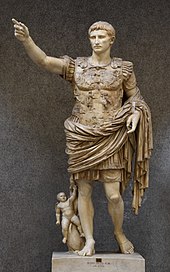
Mu 27 B.C.E., Octavian ndiyo wakaŵa mulongozgi yekha wa Ŵaroma. Pakuŵa mulongozgi wa Ŵaroma, vinthu vikamba kwenda makora chomene mu ufumu wa Ŵaroma, uwo ukatora vyaka 40. Mu caka ici, wakamba kumanyikwa na zina lakuti Augusto. Ŵanthu ŵakulemba mdauko ŵakuwona kuti nyengo iyi ndiyo Ufumu wa Roma ukambira. Nangauli boma likaŵa la boma la Republican, kweni Augusto ndiyo wakaŵa na mazaza ghose. Wupu wa Senate ukamupa udindo wapadera wa Proconsular imperium, uwo ukamupa mazaza pa ŵalongozgi wose ŵa ŵasilikari.
Vigaŵa ivyo vikaŵa pafupi na mphaka, uko ŵasilikari ŵanandi ŵakaŵa, vikaŵa pasi pa muwuso wa Augusto. Vigaŵa ivi vikachemekanga vigaŵa vya ufumu. Vigaŵa vyamtende ivyo vikaŵa pasi pa ŵalara ŵa boma vikaŵa pasi pa mazaza gha ŵalara ŵa boma. Ŵasilikari ŵa Romu ŵakaŵa ŵanandi comene (ŵakaŵa pafupifupi 50) cifukwa ca nkhondo za mukati mwa caru.
Apo vigaŵa vikapangikanga mu Meditereniyani yose, ufumu wa Roma ukaŵa na mazaza ghakupambanapambana, ndipo ukaŵa na mazaza ghakulongozga vigaŵa ("Domina Provinciarum", kung'anamura kuti "muwusi wa vigaŵa", kung'anamura vigaŵa vyose ivyo vikaŵa kuwaro kwa Italy), kweniso mu vyaka vya m'ma 1800 C.E., ufumu wa Roma ukaŵa na mazaza pa charu chose chapasi.[23][24] Chifukwa cha udindo uwu, mu nyengo ya mtende, ŵalara ŵa boma la Roma ŵakagwiliskiranga ntchito mazaza gha ŵapolisi (Imperium domi) m'malo mwa ŵasilikari (Imperium militiae). Ŵanthu ŵa ku Italy ŵakaŵa na wanangwa wa kusopa kweniso ndalama.

Mu muwuso wa Augusto, mabuku gha Ŵaroma ghakakura chomene. Ŵanthu nga ni Vergil, Horace, Ovid, na Rufus ŵakalemba mabuku ghanandi, ndipo ŵakaŵa ŵabwezi ŵa Augusto. Pamoza na Maecenas, wakawovwira ŵanthu kuti ŵaŵe na mtima wa kutemwa caru, nga ni buku la Virgil lakuti Aeneid, kweniso wakawovwira ŵanthu kuti ŵaŵe na mtima wa kutemwa caru. Mabuku agho ghakalembeka mu nyengo iyi ghakaŵako mu nyengo ya Ŵaroma, ndipo ghakaŵa ghakale chomene. Augustus nayo wakalutilira kusintha kalendara iyo Kesare wakakhumbanga, ndipo mwezi wa Ogasiti ukuchemeka na zina lake. Ufumu wa Ŵaroma ukaŵa pa mtende kwa vyaka 200, ndipo vinthu vikendanga makora.[25]
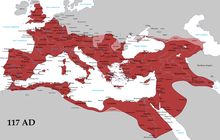
Nangauli ufumu uwu ukaŵa wankhongono, kweni ukalimbikira yayi kuti usanuzge ufumu wake. Mu vyaka vya m'ma 100 na 200, ŵasilikari ŵa Romu ŵakalwanga nkhondo na mafuko gha Chijeremani agho ghakaŵa kumpoto na Ufumu wa Parthiya uwo ukaŵa kumafumiro gha dazi. Pa nyengo yeneyira, ŵanthu ŵakugaluka (nga ni Ŵahebere ku Yudeya) (70) na nkhondo za paŵekha (nga ni mu 68 C.E., mu chaka cha mathemba ghanayi) ŵakakhumbanga kuti ŵasilikari ŵaŵawovwire. Nkhondo za vilimika 70 za Ŵayuda na Ŵaroma izo zikacitika mu hafu yaciŵiri ya vilimika vya mu handiredi lakwamba na hafu yakwamba ya vilimika vya mu handiredi laciŵiri, zikaŵa zakusuzga comene. Ŵayuda 1,356,460 ŵakakomeka pa Nkhondo Yakwamba ya Ŵayuda. Nkhondo Yachiŵiri ya Ŵayuda (115-117), yikakoma Ŵayuda ŵakujumpha 200,000. Ndipo Nkhondo Yachitatu ya Ŵayuda (132-136), yikakoma Ŵayuda ŵakujumpha 580,000. Ŵayuda ŵakaweleramo yayi ku suzgo lawo m'paka apo boma la Israyeli likapangikira mu 1948.
Themba Theodosius I likati lafwa (395 C.E.), Ufumu wa Roma ukagaŵikana. Ku chigaŵa cha kumanjiliro gha dazi kukaŵa masuzgo gha vyachuma na ndyali, kweniso ŵasilikari ŵa Ŵabarabiya ŵakizanga kanandi waka, ntheura msumba wa Mediolanum ukasamukira ku Ravenna. Mu 476, Odoacer wakathereska Romulus Augustulus, themba laumaliro la ku Western. Kwa vyaka vichoko waka, Italy yikalutilira kulamulirika na Odoacer. Pakati pajumpha nyengo yicoko waka kufuma apo Ŵalombardi ŵakanjilira mu caru ici, ndipo pati pajumpha vilimika 1,300, caru ca Italy cikaŵa pasi pa muwusi yumoza.[26]
Middle Ages

Muwuso wa Odoacer ukamara apo Ŵagoth ŵakugalukira caru ca Italy. Pakati pajumpha vyaka vinandi, ŵasilikari ŵa Justinian ŵakanjira mu Italy kuti ŵambeso kulamulira Ŵaroma. Ivi vikawovwira kuti fuko linyake la Cijeremani, la Lombard, liŵe na mazaza pa vigaŵa vikuruvikuru vya Italy. Mu 751 Ŵalombardi ŵakathereska Ravenna, na kumazga muwuso wa Byzantine kumpoto kwa Italy. Pakuwona kuti ŵa Lombard ŵambaso kuwukira, Papa wakapempha wovwiri ku ŵa Frank.[27]
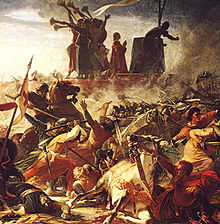
Mu 756 ŵasilikari ŵa Frank ŵakathereska Ŵalombardi ndipo ŵakazomerezga kuti Ŵapapa ndiwo ŵalongozgenge chigaŵa chikuru cha Italy. Mu 800, Papa wakaphakazga Charlemagne kuŵa fumu ya Ufumu wa Roma mu tchalitchi la St. Peter. Charlemagne wakati wafwa (814), ufumu uphya ukaparanyika. Ici cikapangiska kuti mu Italy muŵe suzgo la mazaza. Ivi vikachitika pamoza na kuwuka kwa cisopa ca Ciisilamu mu caru ca Arabia, kumpoto kwa Africa, na ku Middle East. Kumwera, ufumu wa Umayyad na wa Abbasid ndiwo ukambukira. Ku mpoto, boma likamba kuŵa na nkhongono. Mu 852 C.E., Ŵasarayeni ŵakatora msumba wa Bari na kuzenga ufumu. Mu 902 C.E., Ŵasilamu ŵakamba kulamulira Sicily, ndipo ŵakalutilira kulamulira chilumba ichi kufuma mu 965 m'paka mu 1061. Mu vyaka ivi, boma la Italy likamba kujilongozga. Mu vyaka vya m'ma 1000 C.E., malonda ghakamba kuweleramo. Ŵapapa ŵakaŵaso na mazaza ndipo ŵakamba kulimbana na Ufumu wa Ŵaroma.
Mphindano iyi yikamara mu 1122 apo ŵakalemba chikalata chakuchemeka Concordat of Worms, nangauli mu vyaru vinandi vya ku Europe masuzgo ghakaŵako m'paka kuumaliro wa vyaka vya m'ma 1500. Ku mpoto, ŵa Lombard ŵakayezgayezga kuti ŵaŵe ŵakujiyimira paŵekha kufuma ku Ufumu wa Ŵaroma. Kumwera, Ŵanormani ŵakatora vigaŵa vya Ŵalombardi na Ŵabyzantine, ndipo ŵakawuskapo maboma ghaŵiri agha pa chirwa ichi.[28]

Kweniso misumba yinyake iyo yikaŵa yakujiyimira yekha yikathereskeka. Mu nyengo yeneyiyi, Ŵanormani nawo ŵakamazga muwuso wa Ŵasilamu mu Sicily. Mu 1130, Roger II wa ku Sicily wakamba kuwusa Ufumu wa Sicily. Roger II ndiyo wakaŵa fumu yakwamba ya Sicily ndipo wakawovwira kuti vinthu vyose ivyo vikathereskeka na Ŵanormani mu Southern Italy viŵe ufumu umoza. Mu 1155, Fumu Manuel Komnenos yikayezga kuwukira kumwera kwa Italy, kweni yikathera yayi. Ufumu wa Sicily uwo ukaŵa wa ŵanthu ŵa ku Normandy ukakhala m'paka mu 1194 apo ufumu wa Hohenstaufen ukamba kulamulira Sicily. Ufumu wa Sicily ukaŵa pasi pa mafumu ghakupambanapambana m'paka mu ma 1800.

Pakati pa vyaka vya m'ma 1200 na 1300, charu cha Italy chikaŵa na ndyali zapadera chomene. Pakuti mu vyaru vinyake vya ku Europe mukaŵavya maboma agho ghakaŵa na mazaza pa ŵanthu, boma likamba kulamulira mu misumba. Pakuti tchalitchi likaŵa na mazaza pa ŵanthu wose kweniso ufumu ukaŵa kutali chomene, misumba yinandi iyo yikaŵa yakujiyimira payekha yikamba kwenda makora chifukwa cha malonda.
Vikawonekanga nga kuti misumba ya ku Italy yikasintha na kwamba kuchita malonda. Nanga ni misumba na vyaru vya kumpoto vikaŵa na ŵamalonda ŵanandi, comenecomene ŵa ku Venice. Pakuyaniska na maufumu gha ŵamazaza, maboma gha ku Italy ghakaŵa na wanangwa wa ndyali, ndipo ivi vikawovwira kuti sayansi na luso visinthe.
Mu nyengo iyi, misumba yinandi ya ku Italy yikaŵa na maboma nga ni Florence, Lucca, Genoa, Venice, na Siena. Mu vyaka vya m'ma 1300 na 1400, misumba iyi yikazgoka malo ghakurughakuru gha vyamalonda na gha ndalama mu Europe.[29]

Chifukwa chakuti misumba ya ku Italy nga ni Venice yikaŵa pakati pa vyaru vya kumafumiro gha dazi na vya kumanjiliro gha dazi, yikazgoka malo ghakwendeskera malonda gha pa caru cose na gha banki. Milan, Florence, na Venice, pamoza na misumba yinyake yinandi ya ku Italy, yikawovwira comene pa nkhani ya ndalama.
Mu nyengo yeneyiyo pera, mu Italy mukaŵa vyaru vya ku nyanja nga ni Venice, Genoa, Pisa, Amalfi, Ragusa, Ancona, Gaeta na Noli. Kwambira mu 10 m'paka mu 13 C.E., misumba iyi yikazenga ngalaŵa zinandi kuti zijivikilire kweniso kuti zikagwiliskirenge ntchito malonda mu Meditereniyani. Vyaru vya ku nyanja, chomenechomene vya Venice na Genoa, vikazgoka vipata vikuru vya ku Europe vyakwendera malonda na vyaru vya kumafumiro gha dazi. Mu vyaka vyapakati, chigaŵa cha Savoy chikakura na kunjilira mu chigaŵa ichi, ndipo Florence wakazgoka msumba wa malonda na ndalama..[30]
-
Italian Lombard kingdom (781–1014).
-
Emirate of Sicily (831–1072).
Kuwukaso

Ku Italy ndiko kukaŵa ŵanthu ŵanandi awo ŵakakhalanga mu nyengo ya Renaissance.
Kuumaliro wa vyaka vyapakati pa 500 na 1500 C.E., chigaŵa chapakati na kumwera kwa Italy, icho kale chikaŵa pakati pa Ufumu wa Roma na Magna Graecia, chikaŵa chikavu chomene kuluska kumpoto. Msumba wa Romu ukaŵa wakubwanganduka, ndipo boma la Papal States likaŵa na malango ghacoko. Cifukwa cimoza nchakuti Papa wakasamira ku Avignon, France. Naples, Sicily, na Sardinia vikaŵa pasi pa muwuso wa ŵeneco kwa nyengo yitali. Njira za malonda za ku Italy izo zikendanga pa nyanja ya Meditereniyani na kunyake, zikaŵa zikuru comene pakwendeska vinthu. Mu nyengo iyi, misumba iyo yikaŵa mu Italy yikakura chomene ndipo yikaŵa na mazaza ghanandi mwakuti yikaŵa yakujiyimira pawekha.
Mu 1348, ku Italy kukaŵa nthenda ya Black Death iyo yikakoma ŵanthu pafupifupi pa ŵanthu ŵatatu. Kuwelera kwa ŵanthu na suzgo la vyachuma kukapangiska kuti misumba, malonda, na vyachuma viwelerepo, ndipo ivi vikakhozga chomene nyengo ya Humanism na Renaissance (Vyaka vya m'ma 15-16 C.E.) apo Italy yikaŵaso likuru la ŵanthu ŵa ku Western.

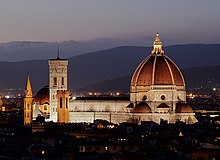

Nyengo iyi yikumanyikwa kuti Renaissance cifukwa cakuti yikaŵa nyengo ya "kuweleramo" mu vinthu vya cuma na vya ku misumba, kweniso ya luso na sayansi. Ŵanthu ŵanyake ŵakuti vinthu vikasintha chomene chifukwa cha mabuku ghakale agho ŵanthu ŵa ku vyaru vya kumanjiliro gha dazi ŵakaluwa kwa vyaka vinandi. Ŵanthu ŵanandi ŵakasamira ku Italy kufuma ku Ufumu wa Roma.
Nyengo ya kuwelera ku Italy yikamba ku Tuscany, mu msumba wa Florence. Kufuma apo, ukafika kumwera, ndipo ukakhwaska chomene msumba wa Romu, uwo ukazengekaso na ŵapositole. Mutaliyana wakamba kuwuka mu vyaka vya m'ma 1500. Vinthu ivyo ŵanthu ŵakagomezganga mu nyengo ya Renaissance vikafuma ku Florence na kuluta ku vyaru vyapafupi nga ni Siena na Lucca. Mulimo wa kuzenga na kupenta wa ŵanthu ŵa ku Tuscany ukaŵa wakovwira chomene ku misumba yose ya kumpoto na pakati pa Italy.
Nyengo ya kuwelera ku Italy yikaŵa yakukondweska comene pa nkhani ya vya cuma. Venice na Genoa ndiwo ŵakamba kuchita malonda agha, pakwamba ŵakaŵa vyaru vya ku nyanja ndipo pamanyuma ŵakamba kuchita malonda agha mu vigaŵa vinyake. Vifukwa vinyake ivyo vikapangiska kuti vinthu ivi viŵeko ni umo nyanja za ku Venice zikaŵira zakukhora pa nkhondo, unandi wa ŵanthu, na umo mabungwe ghakapangikira. Republic of Venice ndiyo yikaŵa msumba wakwamba wa vya ndalama pa caru cose, uwo ukayamba kuzengeka pakati pa vyaka vya m'ma 900 na 1400. Mabondi ghakusinthika ghakaŵako mu nyengo ya ku Italy (nga ni Venice na Genoa) mu nyengo ya kuumaliro wa vyaka vyapakati na kuuyambiro wa nyengo ya Renaissance.[33]
Literature, philosophy, and science
Nkhani za mabuku gha mu nyengo ya Renaissance zikwamba na Petrarch (uyo wakumanyikwa chomene chifukwa cha soneti ya Il Canzoniere kweniso chifukwa cha buku ilo wakalemba) kweniso mubwezi wake Giovanni Boccaccio (uyo wakalemba buku la The Decameron). Ŵaluso ŵanyake awo ŵakamanyikwa comene mu vyaka vya m'ma 1500, ŵakaŵa Luigi Pulci (Morgante), Matteo Maria Boiardo (Orlando Innamorato), na Ludovico Ariosto (Orlando Furioso).
Ŵanthu ŵanyake awo ŵakasambira vya nyengo ya kuwuka kwa Yesu, nga ni Niccolò de' Niccoli na Poggio Bracciolini, ŵakapenja mabuku gha ŵanthu awo ŵakalemba mabuku nga ni Plato, Cicero, na Vitruvius. Mu nyengo ya Ŵakhristu ŵakwambilira, mabuku gha Ŵagiriki na Ŵagiriki (nga ni Plato, Aristotle, Euclid, na Ptolemy) kweniso gha ŵasayansi Ŵachihelamu ghakasangika mu vyaru vya Cikhristu. Ŵasambizgi ŵanyake ŵa Chigiriki ŵa mu nyengo iyi ŵakaŵa ŵasembe ŵaŵiri ŵa ku Seminara ku Calabria. Ŵakaŵa Barlaam wa ku Seminara na msambiri wake Leonzio Pilato wa ku Seminara. Barlaam wakamanyanga comene Cigiriki ndipo ndiyo wakasambizganga Petrarch na Giovanni Boccaccio. Leonzio Pilato wakang'anamulira Giovanni Boccaccio mabuku gha Homer mu Cilatini.
Kuuyambiro wa vyaka vya m'ma 1500, Baldassare Castiglione wakalemba buku lakuti The Book of the Courtier, ilo likulongosora umo munthu wakuwonekera, apo Niccolò Machiavelli wakalemba buku lakuti The Prince. Kweniso likakolerananga yayi na visambizgo vya Chikatolika na visambizgo vya ŵanthu awo ŵakasambizganga vya ndyali.[34][nb 1]
Architecture, sculpture, and painting
Pa nyengo iyi, ŵanthu ŵa ku Europe ŵakamba kutemwana chomene na ŵanthu nga ni Giotto di Bondone, Masaccio, Piero della Francesca, Domenico Ghirlandaio, Perugino, Michelangelo, Raphael, Botticelli, Leonardo da Vinci, na Titian.
Ndimo viliriso na vyakuzenga, nga ni Brunelleschi, Leone Alberti, Andrea Palladio, na Bramante. Ŵakalemba vya tchalitchi la Florence Cathedral, St. Ku Rome kuli Tchalitchi la Petrosi, ndipo ku Rimini kuli Tempio Malatestiano. Paumaliro, kampani ya Aldine Press, iyo yikapangika na Aldo Manuzio, iyo yikachitanga ntchito yake ku Venice, yikamba kulemba mabuku mu Chigiriki chakale.
Kweni nangauli ŵanthu ŵanandi ŵakasuzgikanga na vinthu vya ku malo agha, kweni ŵanthu ŵanyake awo ŵakusanda mdauko ŵakuwona kuti nyengo iyi yikaŵa yakwamba kuti vinthu vyendenge makora mu Italy (chifukwa cha kujura nthowa zakwendakwenda za ku Atlantic na kuwukira vyaru vinyake) kweniso kuti pakaŵavya vinandi ivyo vikachitika pa nkhani ya sayansi.
Age of Discovery
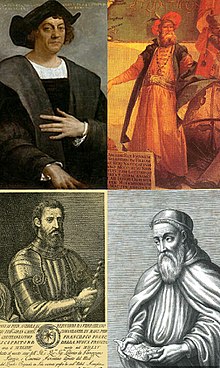
Kuwa kwa msumba wa Constantinople kukapangiska kuti ŵasayansi na mabuku gha Cigiriki ghasamire ku Italy, ndipo ici cikapangiska kuti ŵanthu ŵa Cigiriki na Ciroma ŵambeso kusopa. Ŵalongozgi awo ŵakalongozganga ŵanthu nga ni Federico da Montefeltro na Papa Pius II, ŵakakhumbanga kukhazikiska misumba yiwemi iyo munthu ndiyo wakweruzgira vinthu vyose. Pico della Mirandola wakalemba buku lakuti Oration on the Dignity of Man, ilo likuwoneka kuti ndilo likawovwira kuti ŵanthu ŵaŵe na wanangwa wakusankha. Leonardo Bruni wakaŵa wakwamba kugaŵa mdauko wa ŵanthu mu vigaŵa vitatu: Kale, mu vyaka vyapakati na mazuŵa ghano. Cinthu caciŵiri ico cikacitika cifukwa ca kuwa kwa msumba wa Constantinople cikaŵa kwamba kwa nyengo iyo ŵanthu ŵakamanyanga vinandi.
Ŵalendo ŵa ku Italy ŵakakhumbanga kusanga nthowa yinyake yakuyira ku India kuti ŵajumphe Ufumu wa Ottoman. Ŵanthu ŵakumanyikwa chomene ŵakaŵa: Christopher Columbus (Cristoforo Colombo), uyo wakambiska vyaru vinyake mu Spain, ndipo wakamanya kuti charu cha New World chilipo ndipo ŵanthu ŵa ku Europe ŵakamba kuchisanga. John Cabot (Giovanni Caboto), uyo wakaluta ku England, ndiyo wakaŵa munthu wakwamba wa ku Europe kukendera charu cha North America mu 1497. Amerigo Vespucci, uyo wakaluta ku Portugal, wakalongora mu 1501 kuti charu chiphya (mwakudumura Brazil) chikaŵa cha ku Asia yayi nga umo ŵanthu ŵakaghanaghaniranga pakwamba.[35]
Incessant warfare

Mu vyaka vya m'ma 1400, kumpoto kwa Italy na kumpoto kwa Italy vikagaŵikana mu misumba yinandi iyo yikaŵa pa nkhondo, yikuru chomene yikaŵa Milan, Florence, Pisa, Siena, Genoa, Ferrara, Mantua, Verona, na Venice. Mu nyengo ya ŵapositole, kumpoto kwa Italy kukagaŵikana cifukwa ca kulimbana kwa nyengo yitali pakati pa ŵasilikari ŵa Papa na ŵa Ufumu wa Roma. Msumba uliwose ukaŵa ku chigaŵa chimoza panji chinyake, kweni ukagaŵikana pakati pa ŵasilikari ŵaŵiri, ŵa Guelph na Ghibellines.
Nkhondo pakati pa vyaru vikaŵa vyacilendo yayi, ndipo ŵalwani ŵakufuma ku vyaru vinyake ŵakalutanga waka ku caru ca Italy. Ndyali za mu nyengo ya Renaissance zikamba kufuma mu nyengo iyi. Kwambira mu ma 1300, ŵasilikari awo ŵakateŵeteranga ŵasilikari ŵakuguliskika ŵakaŵanga ŵanthu ŵachoko chomene. Mu vyaka vya m'ma 1500, misumba iyo yikaŵa na mazaza chomene yikamba kulamulira misumba yinyake iyo yikaŵa pafupi nayo. Florence wakathereska Pisa mu 1406, Venice wakathereska Padua na Verona, ndipo Duchy of Milan yikathereska vigaŵa vinyake ivyo vikaŵa kufupi, kusazgapo Pavia na Parma.[36]

Mu nyengo yakwambilira ya muwuso wa Renaissance, ŵanthu ŵakarwanga nkhondo pa mtunda na pa nyanja. Pa caru capasi, nkhondo izi zikacitikanga na ŵasilikari ŵakucemeka condottieri, ŵasilikari awo ŵakafuma mu vyaru vya ku Europe, comenecomene ku Germany na Switzerland. Ŵasilikari aŵa ŵakakhumbanga yayi kuŵika umoyo wawo pangozi, ntheura nkhondo yikamba kuŵa yakuzingilizga, ndipo ŵakachitanga waka vinthu vinyake. Kweniso ŵasilikari awo ŵakagwiranga nchito pa vigaŵa vyose viŵiri ŵakakhumbanga kuti nkhondo yileke kumara. Kweniso ŵantchito awo ŵakagwiranga nchito na ŵasilikari ŵakaŵasuzganga comene. Para vyawoneka kuti boma ndakuthemba comene pa ŵasilikari ŵa nkhondo, ŵasilikari aŵa ŵakayezgekanga comene kuti ŵacitenge ŵekha vinthu.
Ku nyanja, misumba ya ku Italy yikatumanga ŵasilikari ŵanandi ku nkhondo. Ŵalwani ŵakwamba ŵakaŵa Pisa, Genoa, na Venice, kweni ŵati ŵambana kwa nyengo yitali, Ŵagenuwa ŵakamazga nkhondo iyi. Venesia wakaŵa mulwani wankhongono comene, ndipo apo ufumu wa Genoese ukakhiranga mu vyaka vya m'ma 1500, msumba uwu ukaŵa na mazaza pa nyanja. Pakuzgora ku kofya kufuma ku vigaŵa vyakutali, kwamba kuuyambiro wa vyaka vya m'ma 1500, Venice wakamba kukhumba chomene kuwusa malo agha apo nyengo ya kuwuka kwa Ŵ Venetian yikambanga.
Pa caru capasi, Florence, Milan, na Venice ndiwo ŵakaŵa ŵankhongono comene pa nkhondo izo zikacitika kwa vyaka vinandi, ndipo maufumu ghatatu agha ghakaleka mphindano zawo na kuzomerezga Mtende wa Lodi mu 1454. Mtende uwu ukatora vilimika 40, ndipo cifukwa cakuti Venice ndiyo yikaŵa na mazaza pa nyanja, mu vilimika vyose vya m'ma 1500, kukaŵa mtende. Mu vyaka vya m'ma 1400, ŵanthu ŵakwendakwenda nga ni Niccolò Da Conti (1395-1469) ŵakaluta ku vyaru vya kumwera kwa Asia na kuwerako.
Italian Wars
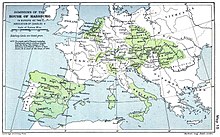
Nkhondo za ku Italy zikamba mu 1494 apo charu cha France chikapoka charu cha Italy. Nkhondo iyi yikamba chifukwa cha mphindano pakati pa ufumu wa Milan na Ufumu wa Naples. Themba la Ufumu wa Roma, Charles V, likathereska Ŵaciroma pa Nkhondo ya ku Pavia (1525) kweniso pa Nkhondo ya Cognac (1526-30). Paumaliro, pamasinda pa nkhondo zinandi izo zikaŵa zambura umaliro, mu 1559, ku Cateau-Cambrésis, France likapangana kuti lileke kukolerana na ivyo likayowoyanga.
Mu 1499, Ŵaturuki ŵakaparanya chigaŵa chikuru cha Venice (kweni msumba wura yayi), ndipo mu 1509 ŵa League of Cambrai ŵakambaso kuwukira na kupoka vinthu. Mu 1528, misumba yinandi ya Apulia na Abbruzzi yikaŵa kuti yapokeka. Cinthu ciheni comene ico cikacitika pa Meyi 6, 1527, apo ŵasilikari ŵa ku Germany ŵakacimbizga msumba wa Roma. Nyengo yitali iyo Florence yikazingilizgika (1529-1530) yikapangiska kuti mizi iyo yikaŵa kufupi na msumba uwu yiparanyike, malonda ghake ghakutumizga vyakurya ku vyaru vinyake ghatimbanizgike, ndipo ŵanthu ŵakayora chuma chawo. Ŵanthu awo ŵakakhalanga mu matawuni gha ku Italy ŵakakhira na hafu. Makampani agho ghakapanganga weya na silika mu Lombardy ghakawa apo ŵasilikari ŵaheni ŵakaparanya vyakulimira vyawo. Ŵasilikari aŵa ŵakakwiya comene cifukwa cakuti ŵakawotcha caru.[37]
Kufuma ku Nkhondo ya ku Kananizgako Chikhristu Mpaka ku Nkhondo ya Napoleon
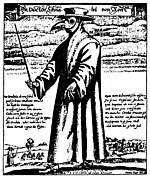
Mdauko wa Italy pamanyuma pa mtende wa Cateau-Cambrésis ukaŵa wa ŵanthu ŵakufuma ku vyaru vinyake. Kumpoto kukaŵa ufumu wa Austrian Habsburgs, ndipo kumwera kukaŵa ufumu wa Spain. Pamanyuma pa nkhondo za ku Europe za m'ma 1700, kumwera kukaŵa kwa ŵa Bourbon ŵa ku Spain ndipo kumpoto kukaŵa kwa nyumba ya Habsburg-Lorraine. Mu nyengo ya Napoleon, caru ca Italy cikapokeka na caru ca France ndipo cikagaŵikana mu vyaru vinandi. Pa ungano wa ku Vienna (1814), vinthu vikaŵa nga umo vikaŵira kuumaliro wa vyaka vya m'ma 1800, kweni vikasinthika mwaluŵiro chifukwa cha umoza wa Italy.
Chuma cha ku Italy chikamba kunangika mu vyaka vya m'ma 1600 na 1700. Pakati pajumpha vyaka 1600, vinthu vikamba kunangika mu Italy. Mu 1600, cigaŵa ca kumpoto na ca pakati pa Italy cikaŵa cimoza mwa vigaŵa vya ku Europe ivyo vikaŵa na mafakitale ghanandi. Ŵanthu ŵakakhalanga makora chomene. Kuzakafika mu 1870, caru ca Italy cikaŵa cakulopwa comene pa nkhani ya vya cuma. Nkhondo, kugaŵikana kwa ndyali, unandi wa ndalama izo ŵanthu ŵakugwiliskira nchito, na kusintha kwa malonda gha caru cose kuya ku mpoto ca kumanjiliro gha dazi kwa Europe na America, vikaŵa vyakuzirwa comene.[38][39]
17th century

Mu vyaka vya m'ma 1700, vinthu vikasintha comene mu Italy. Vinthu ivi vikaŵa nga ni nkhongono za Papa izo zikasazgikira mu caru ici ndiposo umo Tchalitchi la Katolika likacitira pa nyengo iyo pakaŵa kusintha kwa visopa. Nangauli ku Italy kukaŵa vinthu vinandi ivyo ŵanthu ŵakumanya vya sayansi na luso, nga ni ivyo Galileo wakabowozga pa nkhani ya sayansi ya vya mu mlengalenga na sayansi ya vinthu vyakuthupi.
Nangauli ku Italy kukafuma ŵanthu ŵanandi awo ŵakasanda malo nga ni Christopher Columbus, Amerigo Vespucci, na Giovanni da Verrazzano, kweni ŵanthu ŵakasanga malo ghanyake ghapachanya chomene mu charu ichi. Kweniso, cifukwa cakuti Spain yikacitako Nkhondo ya Vyaka Makumi Ghatatu (1618-48), iyo yikagwiliskirika nchito na misonkho iyo yikaŵa pa malo ghake gha ku Italy, yikapangiska kuti malonda na vyakurya vya ku Italy vileke kwenda makora.
Nthenda iyi yikathandazgaso mu Italy. Nthenda ya muliri iyo yikawira kumpoto kwa Italy mu 1630, chomenechomene ku Milan na Venice, yikakoma ŵanthu pafupifupi 1 miliyoni. Nthenda ya muliri ya mu 1656 yikakoma ŵanthu pafupifupi 43 peresenti mu Ufumu wa Naples. Ŵanthu ŵakumanya mdauko ŵakugomezga kuti kuchepa kwa unandi wa ŵanthu mu misumba ya ku Italy ndiko kukachitiska kuti caru ici cileke kuŵa malo ghakurughakuru gha malonda na ndyali. Kuyana na umo ŵanthu ŵakughanaghanira, mu 1500 GDP ya Italy yikaŵa 106% ya GDP ya France, kweni mu 1700 yikaŵa 75% pera.[40]
18th century

Nkhondo ya ku Spain (1701-1714) yikamba cifukwa ca nyifwa ya fumu yaumaliro ya ku Spain, Charles II, uyo wakapeleka chiharo chose ku fumu ya ku Spain, Philip, Duke of Anjou. Pakuwona kuti caru ca France cili na mazaza pa vyaru vinandi vya ku Europe, ku The Hague kukalembeka phangano la Grand Alliance pakati pa Austria, England, Republic of the Netherlands, na vyaru vinyake ivyo vikaŵa na mazaza ghacoko. Wupu uwu ukathereska "Party of the Two Crowns" ya ku France na Spain, ndipo pa phangano la Utrecht na Rastatt, caru ca Italy (Milan, Naples na Sardinia) cikapelekeka ku Austria kufuma ku Spain. Ndipouli, Spain wakayezgaso kutora malo mu Italy na kupoka ufumu wa France mu Nkhondo ya Quadruple Alliance (1718-1720), kweni wakathereskeka. Chifukwa cha phangano la Hague, Spain wakazomera kuleka ivyo Italy yikakhumbanga, apo Duke Victor Amadeus II wa ku Savoy wakazomera kusinthiska Sicily na Austria, na kutorako cirwa ca Sardinia, ndipo pamanyuma pake wakacemeka Themba la Sardinia. Ŵasilikari ŵa ku Spain ŵakapoka Naples na Sicily pamanyuma pa Nkhondo ya Bitonto mu 1738.
Age of Napoleon

At the end of the 18th century, Italy was almost in the same political conditions as in the 16th century; the main differences were that Austria had replaced Spain as the dominant foreign power after the War of Spanish Succession (though the War of the Polish Succession resulted in the re-installment of the Spanish in the south, as the House of Bourbon-Two Sicilies), and that the dukes of Savoy (a mountainous region between Italy and France) had become kings of Sardinia by increasing their Italian possessions, which now included Sardinia and the north-western region of Piedmont.
This situation was shaken in 1796, when the French Army of Italy under Napoleon invaded Italy, with the aims of forcing the First Coalition to abandon Sardinia (still in the hands of the Coalition Kingdom of Sardinia) and forcing Austria to withdraw from Italy. The first battles came on 9 April, between the French and the Piedmontese, and within only two weeks Victor Amadeus III of Sardinia was forced to sign an armistice. On 15 May the French general then entered Milan, where he was welcomed as a liberator. Subsequently, beating off Austrian counterattacks and continuing to advance, he arrived in the Veneto in 1797. Here occurred the Veronese Easters, an act of rebellion against French oppression, that tied down Napoleon for about a week.

Napoleon wakathereska vigaŵa vinandi vya Italy mu zina la French Revolution mu 1797-99. Wakasazgirako maboma ghakale na kugaŵira maboma gha Austria. Wakambiska vyaru vinyake ivyo vikaŵa na malango ghaphya na kuwuskapo wanangwa wa ŵanthu. Ufumu wa Cisalpine wa Napoleon ukaŵa ku Milan. Msumba wa Genoa ukazgoka charu cha Jamhuri, ndipo chigaŵa chake chikazgoka charu cha Liguria. Boma la Romu likapangika kufuma pa vinthu ivyo vikaŵa vya papa apo papa wakatumika ku France. Boma la Naples likaŵa pafupi na Naples, kweni likakhalako myezi yinkhondi pera pambere ŵasilikari ŵa vyaru vinyake ŵandaliwukire. Mu 1805, wakambiska ufumu wa Italy, ndipo iyo wakaŵa fumu ndipo mwana wake waciŵiri wakaŵa mwimiliri. Kweniso, caru ca France cikapangiska kuti caru ca Netherlands ciŵe ca Batavian Republic, ndipo ca Switzerland cikazgoka ca Helvetic Republic. Vyaru vyose ivi vikaŵa vyakulongozgeka na France, ndipo vikeneranga kupeleka ndalama zinandi ku Paris, kweniso kovwira nkhondo za Napoleon. Ndyali na maboma gha mu vyaru ivi ghakaŵa ghaphya, ndipo ŵakamba kugwiliskira ntchito nthowa ya metric. Ŵayuda ŵakaleka kukhala mu misasa ya ŵanthu awo ŵakasopanga ŵangoza. Belgium na Piedmont vikazgoka vigaŵa vya France.[41]

Mu 1805, pamanyuma pakuti France yawina nkhondo ya Third Coalition na kukolerana na boma la Pressburg, Napoléon wakapoka malo gha Veneto na Dalmatia, ndipo wakaghaŵika mu ufumu wa Italy. Mu chaka chenechicho, boma laciŵiri, la Ligurian Republic (ilo likaŵa laciŵiri kwa Republic of Genoa), likakanizgika kuti lijibatane na France. Mu 1806, wakathereska ufumu wa Naples na kuwupeleka kwa munung'una wake ndipo kufuma apo (kufuma mu 1808) kwa Joachim Murat, pamoza na kutolera ŵadumbu ŵake Elisa na Paolina ku ŵakaronga ŵa Massa-Carrara na Guastalla. Mu 1808, wakasazgirako Marche na Tuscany ku Ufumu wa Italy.
Mu 1809, Bonaparte wakawukira Rome, cifukwa ca mphindano na papa, uyo wakamufumiska mu mpingo, ndiposo kuti wasungilire boma lake, wakathemba Papa wakwamba ku Savona ndipo pamanyuma ku France.
Pamanyuma pa Russia, vyaru vinyake vya ku Europe vikakolerana na kuthereska Napoleon pa Nkhondo ya ku Leipzig, ndipo pamanyuma pake vyaru vya Italy ivyo vikaŵa ŵabwezi ŵake, pamoza na Murat, vikamuleka kuti waŵe mubwezi wa Austria. Pakuti wakathereskeka pa nkhondo ya ku Paris pa Epulero 6, 1814, Napoléon wakaleka ufumu wake ndipo wakatumika ku Elba. Pa ungano wa ku Vienna (1814), vinthu vikaŵa nga umo vikaŵira mu 1795, ndipo Italy yikagaŵikana pakati pa Austria (ku mpoto ca kumafumiro gha dazi na Lombardy), Ufumu wa Sardinia, Ufumu wa Sicily (ku mpoto na Sicily), na Tuscany, Papal States na vyaru vinyake vichoko. Ndipouli, maufumu ghakale nga ni Venice na Genoa ghakaŵavya, Venice ghakaŵa gha Austria, ndipo Genoa ghakaŵa gha Ufumu wa Sardinia.
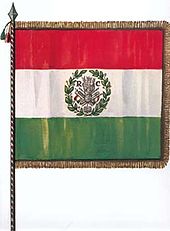
Apo Napoléon wakacimbira na kuwelera ku France (mazuŵa 100), wakapokaso wovwiri wa Murat, kweni Murat wakatondeka kukhorweska Ŵataliyani kuti ŵarwe na Napoléon. Ntheura maufumu gha ku Italy ghakawa, ndipo nyengo ya kuwuskako ufumu wa Italy yikamba. Piedmont, Genoa, na Nice vikaŵa pamoza, nga ni Sardinia (iyo yikapangiska Savoy), apo Lombardy, Veneto, Istria, na Dalmatia vikaŵaso ku Austria. Ŵaduki ŵa ku Parma na Modena ŵakambaso kuwusa, ndipo Ufumu wa Papal na wa Naples ukawelera ku ufumu wa Bourbon. Vinthu vya ndyali na vyakuthupi ivyo vikacitika mu nyengo ya kuwuskako ufumu wa Italy (1815-1835) vikapangiska kuti ŵanthu ŵanandi ŵambuke mu caru cose ca Italy. Vyose ivi vikapangiska kuti Ufumu uphya wa Italy uŵeko.
Frederick Artz wakadidimizgapo uwemi uwo Ŵaitaliya ŵakasanga cifukwa ca Nkhondo ya ku France:
- Kwa vilimika pafupifupi makumi ghaŵiri, ŵanthu ŵa ku Italy ŵakaŵa na malango ghawemi comene, msonkho wakwenelera, vinthu vikaŵayenderanga makora pa vya cuma, kweniso ŵakaŵa ŵakupulikira comene pa nkhani za cisopa na vinjeru.... Ku vigaŵa vyose, mphindano zauzimu, za cuma, na zauzimu zikaŵa kuti zalekeka ndipo Ŵacitaliya ŵakamanya kuti ŵali na caru cimoza..[42]
Mu nyengo ya Napoleon, mu 1797, boma la Italy la Cispadane, ilo likaŵa na mazaza pa caru cose, likamba kutolera ndembera ya ku Italy. Zuŵa ili likucemeka kuti Zuŵa la Tricolour. Mu 1789, ŵakalembapo maluŵa gha ku Italy agho ghakaŵa na mitundu yitatu.[43]
Unification (1814–1861)
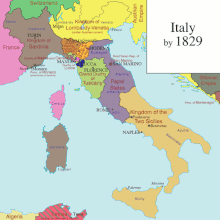
The Risorgimento was the political and social process that unified different states of the Italian peninsula into the single nation of Italy.
It is difficult to pin down exact dates for the beginning and end of Italian reunification, but most scholars agree that it began with the end of Napoleonic rule and the Congress of Vienna in 1815, and approximately ended with the Franco-Prussian War in 1871, though the last "città irredente" did not join the Kingdom of Italy until the Italian victory in World War I.
As Napoleon's reign began to fail, other national monarchs he had installed tried to keep their thrones by feeding those nationalistic sentiments, setting the stage for the revolutions to come. Among these monarchs was the viceroy of Italy, Eugène de Beauharnais, who tried to get Austrian approval for his succession to the Kingdom of Italy, and Joachim Murat, who called for Italian patriots' help for the unification of Italy under his rule.[44] Following the defeat of Napoleonic France, the Congress of Vienna (1815) was convened to redraw the European continent. In Italy, the Congress restored the pre-Napoleonic patchwork of independent governments, either directly ruled or strongly influenced by the prevailing European powers, particularly Austria.


Mu 1820, ŵanthu ŵa ku Spain ŵakagaluka cifukwa ca kususkana na boma lawo. Pakulongozgeka na ŵa Spain (awo mu 1812, ŵakapanga dango lawo), gulu la ŵasilikari ŵa Ufumu wa Sicily ŵaŵiri, ilo likalongozgekanga na Guglielmo Pepe, Carbonaro (munthu wa mu gulu lakubisika la Republican), likagaluka, ndipo likathereska chigaŵa cha Sicily. Themba Ferdinand I likazomera kuti paŵe dango liphya. Ndipouli, ŵanthu ŵakakolerana nawo yayi ndipo ŵasilikari ŵa Austria ŵakathereskeka. Ferdinand wakawuskapo dango la boma ndipo wakamba kutambuzga ŵanthu awo ŵakamanyikwanga kuti ŵakugaluka. Mu vyaka vyakulondezgapo, ŵanthu ŵanandi awo ŵakakolerana na kusintha kwa vinthu ku Sicily, kusazgapo msambiri Michele Amari, ŵakacimbizgika.
Mulongozgi wa gulu la ku Piedmont ilo likawukira boma la Italy mu 1821, wakaŵa Santorre di Santarosa, uyo wakakhumbanga kuwuskapo Ŵaciotiriya na kuwunganya Italy pasi pa nyumba ya Savoy. Nkhondo ya ku Piedmont yikambira ku Alessandria, uko ŵasilikari ŵakamba kuvwara vikhuni vyakututuŵa, vyambura kufipirwa, na vyakututuŵa. Themba Charles Albert, ilo likaŵa mulara wa ŵasilikari, likakhazikiska dango liphya kuti likondweske ŵasilikari. Kweni themba likati lawerako, likakana dango ili ndipo likapempha wovwiri ku wupu wa Holy Alliance. Ŵasilikari ŵa Di Santarosa ŵakathereskeka, ndipo munthu uyo wakakhumbanga kuzgoka wasinthusi wakacimbilira ku Paris.
Pa nyengo iyo, ŵanthu ŵakaghanaghananga kuti nkhondo ya kuwunganya caru ca Italy yikaŵa yakwimikana comene na Ufumu wa Austria na mbumba ya Habsburgs, cifukwa ŵakalongozganga kumpoto kwa Italy uko ŵanthu ŵanandi ŵakayowoyanga Citaliyana. Ufumu wa Austria ukakanizga mtima wa kutemwera caru uwo ukakuranga mu caru ca Italy, kweniso mu vigaŵa vinyake vya ufumu wa Habsburg. Franz Metternich, uyo wakaŵa mulara wa boma la Austria, ndipo wakaŵa na mazaza pa ungano wa ku Vienna, wakayowoya kuti zina lakuti Italy ni "mazgu ghakung'anamura malo".
Kweniso ŵanthu ŵakamba kutemwana chomene na mtundu wawo, ndipo panji ntchito yakumanyikwa chomene iyo ŵanthu ŵakutemwa chomene mtundu wawo ni I Promessi Sposi ya Alessandro Manzoni. Ŵanyake ŵakuwona kuti buku ili likususka waka muwuso wa Austria. Buku ili likalembeka mu 1827, ndipo mu vyaka vyakulondezgapo likasintha chomene. Mu Baibolo la 1840 la I Promessi Sposi, ŵakagwiliskiranga ntchito chiyowoyero cha Tuscan, icho chikaŵa chiyowoyero icho mulembi wakakhumbanga kuti ŵanthu ŵasambire.
Awo ŵakakolerana na umoza uwu ŵakasuskika na Tchalitchi la Katolika, chomenechomene ŵakati ŵayezgayezga kuti ŵaŵe mu wupu wa Papal States. Pa nyengo iyo, papa Pius IX wakafipanga mtima kuti para waleka mazaza ghake mu cigaŵa ici, Ŵakatolika ŵa ku Italy ŵazamutambuzgika.
Nanga ni awo ŵakakhumbanga kuti caru cose ciŵe cimoza, ŵakakolerana yayi umo boma ili licitirenge. Vincenzo Gioberti, wasembe wa ku Piedmont, wakakhumbanga kuti caru cose ca Italy ciŵe pasi pa muwuso wa Papa. Buku lake lakuti, Of the Moral and Civil Primacy of the Italians, likafuma mu 1843. Ŵalongozgi ŵanandi ŵakakhumbanga kuti mu Italy muŵe boma la ŵanthu wose, kweni paumaliro, themba na nduna yikuru ndiyo ŵakaŵa na mazaza ghakukolerana na ŵamazaza ŵa mu Italy.

Gulu linyake la ŵanthu awo ŵakakhumbanga kusintha vinthu likaŵa la Carbonari (awo ŵakawotchanga makala), gulu lakubisika ilo likapangika kumwera kwa Italy kukwambilira kwa m'ma 1800. Gulu ili likafuma mu gulu la ŵanthu ŵakufuma mu magulu gha pakati na ŵavinjeru. Pamanyuma pakuti ungano wa ku Vienna wagaŵa chigaŵa cha Italy pakati pa maufumu gha ku Europe, gulu la Carbonari likasazgikira mu caru ca Papal States, Ufumu wa Sardinia, Grand Duchy of Tuscany, Duchy of Modena, na Ufumu wa Lombardy-Venetia.
Ŵalwani aŵa ŵakaŵawopanga comene mwakuti ŵamazaza ŵakapeleka dango lakuti waliyose uyo wakwiza ku maungano gha Carbonari wakomeke. Ndipouli, wupu uwu ukalutilira kuŵako ndipo ndiwo ukambiska masuzgo ghanandi gha ndyali mu Italy kwambira mu 1820 m'paka apo caru cikaŵa pamoza. Gulu la Carbonari likadumura kuti Napoleon III wakomeke cifukwa ca kutondeka kukolerana na Italy, ndipo likakhala pacoko kuti limukome mu 1858. Ŵalongozgi ŵanandi ŵa gulu ili ŵakaŵa mu gulu ili. (Manyani kuti: Apo wakaŵa muwukirano, Napoleon III wakarwanga ku chigaŵa cha 'Carbonari.')
Pa nyengo iyi, mu 1847, sumu ya Il Canto degli Italiani, iyo yikaŵa sumu ya fuko la Italy kwambira mu 1946, yikamba kwimbika pa wumba. Il Canto degli Italiani, yakulembeka na Goffredo Mameli na kwimbika na Michele Novaro, yikumanyikwaso na zina lakuti Inno di Mameli, kufuma pa mazgu gha uyo wakalemba sumu iyi, panji Fratelli d'Italia, kufuma pa mazgu ghakwamba.[47]

Ŵanthu ŵaŵiri ŵakumanyikwa comene awo ŵakacitanga vinthu mwakutalulira mu gulu ili ŵakaŵa Giuseppe Mazzini na Giuseppe Garibaldi. Ŵanthu awo ŵakalondezganga fundo za boma lakwamba ŵakaŵa Count of Cavour na Victor Emmanuel II, uyo pamasinda wakaŵa fumu yakwamba ya Italy.
Mazzini wakajalirika mu jele chifukwa cha ivyo wakacitanga. Apo wakaŵa mu jere, wakawona kuti caru ca Italy cingaŵa cakukolerana ndipo wakalemba pulogiramu yake ya kukhazikiska caru cakufwatuka, cakukolerana na boma la Roma. Mazzini wakati wafuma mu jele mu 1831, wakaluta ku Marseille, uko wakambiska gulu liphya la ndyali lakucemeka La Giovine Italia. Gulu liphya ili likaŵa na mazgu ghakuti "Chiuta na Ŵanthu", ndipo likakhumbanga kuti Italy wakoleranenge.
Ufumu wa Italy ukaŵako cifukwa ca kuyezgayezga kwa ŵanthu ŵa ku Italy awo ŵakakolerananga na nyumba ya Savoy.
Ufumu wa Sardinia ukaŵa wa vyamalonda kwambira mu 1830. Dango lakwamba, la Statuto Albertino, likapelekeka mu 1848, mu chaka icho kukaŵa viwawa. Pa nyengo yeneyira, ŵasilikari ŵa Austria nawo ŵakamba nkhondo yakwamba ya ku Italy. Nkhondo iyi yikati yamara, vinthu vikasintha ndipo ufumu wa Sardinia ukathera.
Garibaldi, uyo wakababikira mu msumba wa Nice (uyo panyengo iyo ukaŵa ku Ufumu wa Sardinia), wakacitako chigaluka mu Piedmont mu 1834, ndipo wakeruzgika kuti wakomeke. Wakakhalako vyaka 14, ndipo wakachitako nkhondo zinandi.
Pamanyuma pa Nkhondo za 1848, mulongozgi wa gulu ilo likakhumbanga kuti caru ca Italy ciŵe cimoza wakaŵa Giuseppe Garibaldi. Ŵanthu ŵa ku Italy ŵakamutemwanga comene. Garibaldi ndiyo wakalongozganga gulu la ku Italy ilo likakhumbanga kuti caru cose ciŵe cimoza, kweni ufumu wa kumpoto kwa Italy wa nyumba ya Savoy mu ufumu wa Piedmont-Sardinia uwo ukalongozgekanga na Camillo Benso, Count of Cavour, nawo ŵakakhumbanga kukhazikiska boma la Italy. Nangauli ufumu uwu ukaŵa kuti ulije kukolerana na ufumu wa Roma (uwo ukaŵa msumba ukuru wa Italy), kweni ukalimbana na Austria mu Nkhondo Yachiŵiri ya ku Italy. Kuyana na phangano la Plombières, ufumu wa Sardinia ukapeleka Savoy na Nice ku France, ndipo ici cikapangiska kuti ŵanthu ŵa ku Niçard ŵafumemo mu caru cawo. Ufumu uwu ukaŵa na mabungwe ghakuzirwa agho ghakawovwira kuti Italy wambe kukolerana, nga ni Britain na France mu Nkhondo ya ku Crimea.
Mu 1871, Giuseppe Garibaldi wakasankhika kuŵa mulara wa boma ku Nice, uko wakayezga kukhozgera kuti msumba wake uŵe chigaŵa cha Italy, kweni ŵakamukanira kuyowoya. Cifukwa ca kukana, pakati pa 1871 na 1872 kukaŵa vivulupi mu msumba wa Nice, ivyo vikaciskika na Garibaldini ndipo vikacemekanga "Niçard Vespers", ivyo vikakhumbanga kuti msumba uwu na vigaŵa vyake viŵikike mu Italy. Ŵanthu 15 ŵa ku Nice awo ŵakacitako cigaluka ici ŵakeruzgika.[48]
Southern question and Italian diaspora

Kumwera kwa charu ichi (Mezzogiorno) vinthu vikenda makora yayi. Mulimo wa kuwunganya na kusinthiska vinthu ukapangiska kuti kumpoto na kumwera kwa Italy kuŵe kugaŵikana. Ŵanthu ŵakasuskanga vyaru vya kumwera kuti ni "vyakukhalira kumanyuma" ndiposo vyautesi, kweni nadi, pakuyaniska na vyaru vya kumpoto kwa Italy, "uko kukaŵa kukhalira kumanyuma, nyengo zose kukaŵanga vinthu vinyake ivyo vikawovwiranga". Mbunenesko kuti pakeneranga kuŵa vifukwa vyakupulikikwa vyakupatulira kumwera nga umo vikaŵira na Italy. Chigaŵa chose cha kumwera kwa Naples chikaŵa na masuzgo ghanandi gha vyachuma na gha ŵanthu. Ndipouli, masuzgo ghanandi gha ndyali gha ku South na lumbiri lwake lwa kuŵa "wakukhazikika" panji wauleŵi (kuyana na ndyali) ghakaŵako cifukwa ca boma liphya (ilo likababika cifukwa ca kukhumba kuti caru ca Italy ciŵe cakukhora) ilo likapatuska ŵanthu ŵa ku South na kuŵakanizga kuyowoyapo pa nkhani zakuzirwa. Ndipouli, vinthu vikaŵa vyakusuzga, dongo likaŵa lambura vipambi vinandi, nkhorongo yikakhalanga makora yayi, makampani ghanandi ghakakhalanga waka pa malo ghake chifukwa cha msonkho ukuru, malo ghakuru ghakaŵa ghambura kulongozgeka makora, ŵalimi ŵanandi ŵakaŵa na malo ghacoko comene, kweniso kukaŵa ŵanthu ŵanandi ŵambura nchito kweniso ucigeŵenga.[49]


Cavour wakaghanaghana kuti suzgo likuru likaŵa boma liheni, ndipo wakagomezganga kuti lingamazgikaso para malango gha ku Piedmont ghangalondezga. Ici cikapangiska kuti ŵanthu ŵanandi ŵambe kunanga vinthu, ndipo ici cikapangiska kuti paŵe nkhondo iyo yikatora vilimika pafupifupi 10. Nkhondo iyi yikafika paheni comene comene ku Basilicata na kumpoto kwa Apulia, ndipo yikalongozgekanga na Carmine Crocco na Michele Caruso. Nkhondo ya ku South America yikati yamara, ŵanthu ŵanandi ŵa ku Italy ŵakaluta ku United States na South America. Ŵanyake ŵakasamira ku misumba ya kumpoto ya vyamalonda nga ni Genoa, Milan, na Turin, ndipo ŵakatumizga ndalama kukwawo.
Ŵanthu ŵakwambilira ŵa ku Italy awo ŵakasamira ku vyaru vinyake ŵakamba kuzingilizga charu cha Italy mu 1880, vyaka 20 pamanyuma pakuti charu ichi chazakaŵa pamoza. Ukavu ukaŵa cifukwa cikuru ico ŵanthu ŵakasamukiranga ku vyaru vinyake, comenecomene cifukwa ca kusoŵerwa kwa malo. Mu chigaŵa cha kumwera kwa Italy vinthu vikaŵa makora yayi. M'paka m'ma 1860 m'paka m'ma 1950, chigaŵa chikuru cha Italy chikaŵa ku mizi ndipo chikaŵa na matawuni ghachoko waka.
Cinthu cinyake ico cikapangiska kuti ŵanthu ŵanandi ŵakhalenge mu vigaŵa vya kumwera kwa Italy, nchakuti vinthu vikamba kwenda makora pa umoyo wa ŵanthu. Ici cikapangiska kuti ŵanthu ŵanandi ŵambe kusama ndipo cikapangiska kuti miwiro yiphya yisame mu vyaru vinandi kuumaliro wa vyaka vya m'ma 1800 na kukwambilira kwa vyaka vya m'ma 1900, comenecomene ku America. Kusama kwa ndalama kukapangiska kuti pa caru cose paŵe nchito zinandi za ŵanthu ŵambura maluso ndipo kukacitiska kuti ŵanthu ŵanandi ŵa ku Italy ŵasamire mu vyaru vinyake kuti ŵagure "ganyu na cingwa".[50]

Mu nyengo ya ku Italy, charu ichi chikaŵa na ŵasilikari ŵanandi chomene. Ndipouli, cifukwa ca kupasuka kwa muwuso wa ŵasilikari na kugaŵa malo, ŵalimi ŵacokoŵacoko ŵa kumwera ŵakeneranga yayi kuŵa na malo ghawo panji malo agho ŵangagwirako nchito na kusangapo candulo. Ŵanandi ŵakaŵavya malo, ndipo malo ghakaŵa ghacoko na ghacoko, ndipo ghakaŵa ghambura kupambika makora, cifukwa caru cikagaŵikanga pakati pa ŵahaliri.
Pakati pa 1860 na Nkhondo Yakwamba ya Caru Cose, ŵanthu 9 miliyoni ŵa ku Italy ŵakafumapo pa ŵanthu 16 miliyoni awo ŵakaluta ku caru cinyake, ndipo ŵanandi ŵakaluta ku North panji South America. Kafukufuku munyake wakulongora kuti kufuma mu 1876 m'paka 1914, ŵanthu aŵa ŵakakwana 14 miliyoni. Pa ciŵelengero ca ŵanthu awo ŵakafumanga mu caru cawo mu 1876 m'paka 1900, ŵanthu pafupifupi 220,000 ŵakafumanga mu caru ici. Pambere chaka cha 1900 chindafike, ŵanthu ŵanandi ŵa ku Italy ŵakafumanga kumpoto na pakati pa Italy. Pa ŵanthu wose awo ŵakafuma mu Italy pakati pa 1870 na 1914, ŵanthu ŵaŵiri pa ŵatatu ŵakaŵa ŵanalume awo ŵakaŵa na maluso ghakupambanapambana. Ŵalimi ndiwo ŵakaŵa hafu ya ŵanthu wose awo ŵakafumanga mu vyaru vinyake pambere chaka cha 1896 chindafike.
Ŵalendo ŵakalutilira kukhozga ubwezi wawo na caru cawo nanga ni para ŵafuma. Ŵanthu ŵanandi ŵa ku Italy awo ŵakafuma mu vyaru vinyake ŵakapeleka vyawanangwa kuti ŵakazenge Altare della Patria (1885~1935), chigaŵa cha chikumbusko cha Themba Victor Emmanuel II la ku Italy. Ng'anamuro la ntharika ya moto uwo ukubuka kwamuyirayira likukolerana na vimanyikwiro vya moto uwu. Moto uwo ukubuka kwamuyirayira ukulongora kuti ŵanthu ŵa ku Italy ŵakukumbuka sembe ya msilikari wambura kumanyikwa na kukolerana na caru cawo.[51]
Liberal period (1861–1922)
Pa 17 Malichi, 1861, caru ca Italy cikazgoka boma la ŵanthu, apo vyaru vinandi vya pa cigaŵa ici vikaŵa pasi pa muwuso wa fumu Victor Emmanuel II wa nyumba ya Savoy, uyo wakalamuliranga Piedmont. Ŵanthu awo ŵakambiska kuti caru ca Italy ciŵe cimoza ŵakaŵa Camillo Benso, Count of Cavour, nduna yikuru ya boma la Victor Emmanuel, na Giuseppe Garibaldi, mulara wa ŵasilikari na munthu wakuzirwa comene. Mu 1866, Otto von Bismarck, nduna yikuru ya ku Prussia, wakaphalira Victor Emmanuel II kuti waŵe mubwezi wa Ufumu wa Prussia. Pakuwezgera, Prussia wakazomerezga Italy kuti wapoke Venice. Themba Emmanuel likazomera ndipo Nkhondo Yachitatu ya ku Italy yikamba. Cifukwa ca kutonda ku Austria, caru ca Italy cikapoka Venice. Cinthu cimoza ico cikapangiska kuti caru ca Italy cileke kukolerana cikaŵa Roma.
Mu 1870, caru ca France cikamba nkhondo ya ku France na Prussia ndipo cikawezga ŵasilikari ŵake ku Rome, uko ŵakaleka kuti papa waŵe na mazaza. Italy wakawukira boma la Papa. Ŵakazomerezga kuti caru ca Italy ciŵe cimoza, ndipo msumba ukuru wa caru ici ukafumako ku Florence kuya ku Roma.
Vinyake mwa vyaru ivyo vikaŵa vyakuti vinganjira mu ufumu wa Italy (terre irredente), nga ni Trentino-Alto Adige na Julian March, vikaŵamo yayi mu ufumu uwu m'paka mu 1918 apo Italy yikathereska Austria-Hungary mu Nkhondo Yakwamba ya Caru Cose. Pa cifukwa ici, nyengo zinyake awo ŵakulemba mdauko ŵakuyowoya kuti nyengo ya kuwungana yikamara mu 1871, kusazgapo ivyo vikacitika kuumaliro wa vyaka vya m'ma 1800 na Nkhondo Yakwamba ya Caru Cose (1915-1918), ndipo yikamara na phangano la nkhondo la Villa Giusti pa Novembala 4, 1918. Fundo iyi yikulongosoreka makora chomene pa nyengo ya kuwungana kwa Roma.[52][53]

Ku Northern Italy, mulimo wa kupanga vinthu na kuzgora vinthu vinyake kuŵa viphya ukamba kuumaliro wa vyaka vya m'ma 1800. Pa nyengo yeneyira, ŵanthu ŵanandi ŵakakhalanga ku mizi ya kumwera, ndipo ŵanthu mamiliyoni ghanandi ŵakachimbilira ku vyaru vinyake kukapenja umoyo uwemi. Ŵanthu ŵanyake ŵakuti ŵanthu pafupifupi 1 miliyoni ŵa ku Italy ŵakasamukira ku vyaru vinyake vya ku Europe nga ni France, Switzerland, Germany, Belgium, na Luxembourg, kweniso ku America.
Mu vyaka vya m'ma 1800, boma laparamendi likakura comene. Dango la ku Sardinia ilo likalembeka mu 1848, likapelekaso wanangwa ku ŵanthu wose ŵa mu Ufumu wa Italy mu 1861.
Ndyali za ku Italy zikagaŵikana pakati pa magulu ghakupambanapambana gha kumalyero na kumalyero, ivyo vikapangiska kuti maboma ghaŵe mu suzgo. Mu 1876, Minghetti wakataya mazaza ndipo wakasinthika na Agostino Depretis, uyo wakamba kulamulira mu 1880s, kweni wakalutilira kuyezga kukhozga ŵakususka kuti ŵalutilire kuŵa na mazaza.
Depretis

Depretis wakamba uteŵeti wake pakuŵa nduna yikuru mwa kwamba kughanaghana vya ndyali, zina lake Trasformismo. Fundo ya Trasformismo yikaŵa yakuti boma likwenera kusankha ŵandyali ŵakuzika na ŵakwenelera kufuma mu vigaŵa vyambura kupindikana. Depretis wakapangiska kuti ŵanthu ŵa mu vigaŵa vyake ŵamuvotere usange ŵakukhumba kuti Depretis waŵawovwire. Mu 1876, pakaŵa ŵimiliri ŵanayi pera awo ŵakasankhika kufuma ku chigaŵa chakumanjiliro. Ŵanthu ŵakugomezga kuti Depretis wakathereskeka cifukwa ca nkharo yake ya nkhaza. Depretis wakathereska ŵanthu ŵankhaza, nga nkhukanizga maungano gha pa wumba, kupeleka ŵanthu "ŵakofya" ku vigaŵa vyakutali mu Italy, na kwendera ndyali. Depretis wakapangiska malango agho ghakaŵa na mphindano pa nyengo iyo, nga nkhulekeska kukakika chifukwa cha ngongoli, kuŵika sukulu ya pulayimale kuti yiŵe yaulere kweniso yakukhumbikwa.
Boma lakwamba la Depretis likamara mu 1877 apo wakafumiskanga nduna yake ya mukati. Boma laciŵiri la Depretis likamba mu 1881. Mu 1882, Depretis wakakhumbanga kusazgirako wanangwa wa ŵanthu ŵa ku Italy wa kusankha, kusazgirako misonkho iyo ŵanthu ŵa ku Italy ŵakeneranga kupeleka. Mu 1887, Depretis wakafumiskika pa udindo wake pamanyuma pa vilimika vinandi vya kutondeka kwa ndyali.
Crispi

Francesco Crispi (1818–1901) was Prime Minister for a total of six years, from 1887 until 1891 and again from 1893 until 1896. Historian R.J.B. Bosworth says of his foreign policy that Crispi:
Pursued policies whose openly aggressive character would not be equaled until the days of the Fascist regime. Crispi increased military expenditure, talked cheerfully of a European conflagration, and alarmed his German or British friends with his suggestions of preventative attacks on his enemies. His policies were ruinous, both for Italy's trade with France, and, more humiliatingly, for colonial ambitions in East Africa. Crispi's lust for territory there was thwarted when on 1 March 1896, the armies of Ethiopian Emperor Menelik routed Italian forces at Adowa, ... In what has been defined as an unparalleled disaster for a modern army. Crispi, whose private life (he was perhaps a trigamist) and personal finances...were objects of perennial scandal, went into dishonorable retirement.[54]

Crispi wakaŵa mu nduna ya Depretis ndipo nyengo yinyake wakaŵa wa Garibaldi. Mu 1887 m'paka 1891, Crispi wakafipiranga mtima chomene kuvikilira Italy ku Austria-Hungary. Crispi wakalimbikiranga ntchito ya kuzenga Italy kuŵa ufumu wankhongono wa pa caru cose kwizira mu kunjizga ndarama za nkhondo, kukhozgera kutandazgika kwa caru, na kuyezga kuti Germany yikondwe nayo nangauli wakajibatika ku Triple Alliance iyo yikaŵa na Germany na Austria-Hungary mu 1882. Apo wakawovwiranga Italy kuti waŵe wakukhora, wakalutilira kusintha vinthu ndipo wakaŵa na mazaza, nyengo yinyake wakakhumbanga kuti boma liŵike dango lakukanizga vyaru vinyake. Nangauli Crispi wakaŵa wankhongono, kweni wakasintha vinthu vinyake nga ni Dango la vya Umoyo wa Ŵanthu la mu 1888 na kukhazikiska makhoti kuti boma liwezge masuzgo.
Ŵanthu ŵa viŵeto awo ŵakakhumbikwiranga wovwiri ŵakakhuŵara comene cifukwa ca kuŵika mtima comene pa ndyali. Ŵalongozgi ŵa ndyali na ŵa visopa vinyake ŵakakhumbanga kuti boma lisande umo lingawovwilira vyakurya mu Italy. Kafukufuku uyo wakamba mu 1877 ndipo wakafumiskika pakati pajumpha vilimika vinkhondi na viŵiri, wakalongora kuti vyakurya vikendanga makora yayi, kuti ŵeneco ŵa malo ŵakarya ndalama izo ŵakasanganga pa malo ghawo ndipo ŵakovwira comene yayi kuti malo ghawo ghamere makora. Ŵanthu ŵa ku Italy awo ŵakakhalanga mu vigaŵa vya pasi ŵakakwiya comene cifukwa ca kugaŵikana kwa malo agho ghakaŵa gha ŵanthu wose. Ŵanandi awo ŵakagwiranga nchito mu minda iyi ŵakaŵa ŵalimi yayi, kweni ŵantchito ŵacoko waka awo ŵakagwiranga nchito kwa cilimika cimoza. Ŵalimi ŵambura ndalama ŵakakhalanga na vyakurya vichoko waka, matenda ghakathandazgikanga mwaluŵiro, ndipo kukaŵa nthenda zakwambukira, kusazgapo nthenda yikuru ya kolera iyo yikakoma ŵanthu pafupifupi 55,000.
Boma la Italy likatondeka kumazga makora suzgo ili cifukwa ca ndalama zinandi izo boma la Depretis likagwiliskiranga nchito. Charu cha Italy nacho chikasuzgika comene cifukwa cakuti mu ma 1870 na ma 1880, ŵakapanganga mpheska zinandi comene. Pa nyengo iyi, caru ca Italy cikaŵa cakuluska comene pa vyakurya vyose mu Europe, kweni cifukwa ca kuwelera kwa vyakurya ku France mu 1888, kumwera kwa Italy kukaŵa na vyakurya vinandi comene.[55]

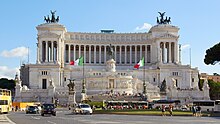
Giolitti
Kufuma mu 1901 m'paka 1914, Giovanni Giolitti ndiyo wakalamuliranga ndyali na mbiri ya Italy. Pakwamba, wakasangana na ŵanthu ŵanandi awo ŵakakondwa yayi na ivyo Crispi wakacita. Ndipo pa nyengo yakwamba iyi apo ŵakuru na ŵasungwana ŵakakumananga, Giolitti wakawovwira kuti vinthu viŵe viphya mu ndyali pakati pa vyaka vya m'ma 1800 na 1900. Kulekerathu kukanizga ŵanthu, kweni kuzomerezga kuti ŵanthu ŵacite viyezgo, ndiposo kuti ŵaleke kugwira nchito, kweni kuti ŵaleke kuŵa ŵankhaza panji ŵa ndyali.
Ivyo Giolitti wakacita vikakhwaska comene umoyo wa ŵanthu na nchito, ŵanalume wose ŵakaŵa na wanangwa wa kusankha, njanji na makampani gha inshuwalansi vikaŵa vya caru cose, ngongoli ya boma yikakhira, vinthu vyapasi vikamba kwenda makora, ndipo makampani ghakamba kupanga vinthu. Mu vyaru vinyake, ŵanthu ŵakamba kufumako ku Germany na Austria na Hungary na kwamba kukolerana na France, Great Britain, na Russia. Kwambira mu vyaka vya m'ma 1800 C.E., caru ca Italy cikaŵa na ufumu wake. Likatora ufumu wa Somalia. Boma la Ethiopia likathera yayi pa Nkhondo Yakwamba ya ku Italy na Ethiopia mu 1895-1896. Mu 1911, boma la Giolitti likatuma ŵasilikari ŵake kuti ŵakakome Libya. Pakati pajumpha nyengo yichoko waka, charu cha Italy chikapoka charu cha Libya (chenechicho chikaŵa ku Tripolitania na Cyrenaica) na virwa vya Dodecanese. Ŵalongozgi ŵa visopa ŵakakhumbanga kuti caru ca Italy ciŵe na mazaza pa Nyanja ya Meditereniyani mwa kutora caru ca Greece na dera la Dalmatia ilo lili mumphepete mwa nyanja ya Adriatic, kweni ŵakaŵikapo mtima yayi.
Mu Juni 1914, boma likakanaso ŵanthu ŵakumanjilira kumalyero ŵati ŵakoma ŵanthu ŵatatu awo ŵakasuskanga ŵasilikari. Ŵanthu ŵanandi ŵakumanjiliro ŵakasuska ndipo chipani cha Italian Socialist Party chikapharazga kuti ŵanthu wose mu Italy ŵali mu viwawa. Ŵanthu ŵakamba kusuzgika chomene na vinthu vyambura urunji ivyo vikachitikanga mu misumba yikuruyikuru na mizi yichoko. Ndipouli, pati pajumpha mazuŵa ghaŵiri pera, ungano uwu ukaleka, nangauli nkhondo yikalutilira.[56]
World War I and failure of the liberal state
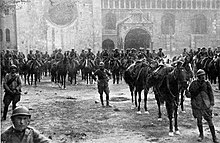
Italy yikanjira mu Nkhondo Yakwamba ya Caru Cose mu 1915 na cilato ca kumalizga umoza wa chalo: pa cifukwa ici, kunjilirapo kwa Italy mu Nkhondo Yakwamba ya Caru Cose kukuwonekaso nga ni Nkhondo Yacinayi ya ku Italiya ya Kujiyimira paŵekha, mu kawonekero ka historiographical ako kakulongora kuti nkondo iyi yikaŵa umaliro wa kuwungana kwa Italy, uko kukacitika nkhondo ya nkhondo iyo yikayamba mu 1848 na Nkhondo Yakwamba ya ku Italiya.
Nkhondo Yakwamba ya Caru Cose (1914-1918) yikaŵa cakucitika cambura kunozgekera ico cikapangiska kuti ŵambe kusopa pamoza na Germany na Austria. Kwa myezi yinkhondi na umoza, caru ca Italy cikaŵa cambura kuvikilira, cifukwa cakuti ŵasilikari ŵa Triple Alliance ŵakaŵanga na mulimo wa kuvikilira caru. Mu 1915, ŵanthu ŵa ku Italy ŵakanjira mu nkhondo iyi nangauli ŵakakhumbanga yayi kunjilirapo. Charu cha Italy chikaŵa chikuru kweniso chikaŵa mukavu. Wupu wa Triple Alliance ukaŵa wakuzirwa viŵi yayi ku Italy panji ku Austria. Ŵanalume ŵaŵiri, nduna yikuru Antonio Salandra na nduna ya vyaru vinyake Sidney Sonnino ndiwo ŵakasankhanga vinthu vyose, nga ni umo vikaŵira mu ndyali za ku Italy. Ŵakacitanga vinthu mwakubisilizga, ndipo pamasinda ŵakalembeska themba, kweni ŵasilikari na ŵalongozgi ŵa ndyali ŵakamanyanga yayi. Ŵakapangana na vigaŵa vyose viŵiri kuti ŵasangane ndalama zinandi, ndipo ŵakasanga ndalama kufuma ku ŵasilikari ŵa Entente, awo ŵakakhumbanga kuŵalayizga vigaŵa vikuruvikuru vya Ufumu wa Austria-Hungary, kusazgapo Tyrol na Trieste, kweniso kuti Albania waŵe chigaŵa chakutetezgeka. Russia wakakana kupeleka Dalmatia ku Italy. Britain yikaŵa yakunozgeka kupeleka wovwiri na ngongoli kuti yikope ŵanthu 36 miliyoni ŵa ku Italy kuŵa ŵabwezi ŵaphya awo ŵakasuzganga Austria kumwera.[61]

Mu Meyi 1915, pakapharazgika phangano la ku London. Salandra wakafumapo pa udindo wake, kweni pakaŵavya munthu uyo wakawovwira kuti paŵe ŵanthu ŵanandi. Ŵanandi ŵa ndyali, kweniso ŵanthu ŵanandi ŵa ku Italy, ŵakasuskanga nkhondo, kusazgapo Ŵakatolika ŵanandi. Malipoti agho ghakafuma ku Italy ghakulongora kuti ŵanthu ŵakawopanga nkhondo, ndipo ŵakakondwanga yayi na malo. Ŵanthu ŵa ku mizi ŵakawonanga nkhondo kuŵa soka, nga ni chilangalanga, njara, panji nthenda yakofya. Ŵamalonda ŵanandi ŵakasuskanga, cifukwa ŵakawopanga kuti boma lingaŵakanizga kuguliska vinthu na misonkho yinandi, kweniso kuti ŵangaluza malonda ghawo. Vikaŵa nga vingachitika yayi kuti ŵasintheso ivyo ŵakadumura, cifukwa ŵasilikari ŵa Triple Alliance ŵakakhumbanga yayi kuti Italy wawelere, ndipo ufumu wa themba ukaŵa pangozi. Ŵanthu ŵanandi awo ŵakakolerana na nkhondo ŵakafuma mu misewu, ŵakachemerezganga kuti: "Tiyeni, tiyeni, tiyeni!" Benito Mussolini, uyo wakaŵa mulembi wa Socialist Party, wakaŵa mulongozgi, kweni ŵakamucimbizga mu chipani ndipo ŵanthu ŵacoko waka ndiwo ŵakamulondezga. Padera pa caru ca Russia, ici cikaŵa cipani cimoza pera ku Europe ico cikasuskanga nkhondo. Nkhondo iyi yikaŵa yankhaza comene cifukwa ca ndyali, kutondeka, kukhuŵara, na ucindere wa ŵamazaza.[62][63]
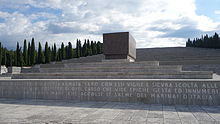
Italy wakanjira mu nkhondo na ŵasilikari ŵakukwana 875,000, kweni ŵasilikari aŵa ŵakaŵa ŵambura kulongozgeka makora ndipo ŵakaŵavya vilwero vikuru vya nkhondo.
Ŵasilikari ŵa ku Italy ŵakatondeka kumazga nkhondo iyi, cifukwa ŵasilikari ŵa ku Austria ndiwo ŵakaŵa na mazaza pa nkhondo iyi. Mu 1916, caru ca Italy cikapharazga nkhondo ku Germany, ndipo ici cikapeleka wovwiri ukuru ku Ŵaustria. Ŵasilikari ŵa Italy ŵakukwana 650,000 ŵakafwa ndipo 950,000 ŵakapwetekeka, apo chuma chikakhumbikwiranga wovwiri wa ŵasilikari ŵa vyaru vinyake kuti chileke kunangika.
Pambere nkhondo yindambe, boma likaŵikako mahara yayi ku nkhani za ŵantchito, kweni sono likakhumbikwiranga kunjilirapo kuti liŵawovwire. Pakuti chipani chikuru cha Socialist chikakhumbanga yayi kovwira nkhondo, ŵanthu ŵakachitanga viwawa kanandi waka ndipo ŵakakolerananga viŵi yayi, comenecomene mu vigaŵa vya Piedmont na Lombardy. Boma likakhazikiska malipiro ghapachanya, ndipo likaŵikapo mtima kuti ŵantchito ŵagwirenge lumoza ntchito.
Makampani ghakurughakuru ghakakura comene. Ŵantchito ŵa Ansaldo ŵakakwera kufuma pa 6,000 kufika pa 110,000, ndipo ŵakapanga vilwero 10,900, ndege za nkhondo 3,800, ngaraŵa za nkhondo 95, na mabomba 10 miliyoni. Pa kampani ya Fiat, ŵantchito ŵakakwera kufuma pa 4,000 kufika pa 40,000. Chifukwa cha kukwera kwa ndalama, ndalama zikakwera chomene. Malipiro gha ŵantchito ghakakwera, kweni gha ŵalimi ghakakwera yayi. Ŵanthu ŵanandi ŵakakondwa yayi na ivyo vikachitikanga ku mizi, cifukwa cakuti ŵanalume ŵanandi ŵakagwiranga nchito, nchito mu mafakitale zikaŵavya, malipiro ghakakweranga pacoko, ndipo kusinthasintha kwa vinthu kukaŵa kuheni comene.
Nkhondo iyi yikaŵa yakumalizga nkhondo ya ku Italy, yikapangiska kuti Ufumu wa Austria na Hungary uparanyike, ndipo yikawovwira kuti Nkhondo Yakwamba ya Caru Cose yimare pakati pajumpha masabata ghaŵiri. Ŵasilikari ŵakujumpha 651,000 ŵa ku Italy ŵakafwa pa nkhondo ya pa caru cose. Ŵanthu ŵa ku Italy awo ŵakafwa cifukwa ca kusoŵa cakurya ŵakakwana 589,000.
Nkhondo yikati yamara, Vittorio Emanuele Orlando, nduna yikuru ya Italy, wakakumana na David Lloyd George, nduna yikuru ya Britain, Georges Clemenceau, nduna yikuru ya France, na Woodrow Wilson, nduna yikuru ya United States, ku Versailles, kuti ŵadumbiskane umo mphaka za ku Europe zikwenera kuŵikikira mwakuti nkhondo ya ku Europe yileke kucitika.
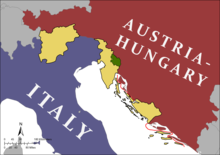
Pa nyengo iyi, Wilson wakalayizga kuti mitundu yose ya ku Europe yizamuŵa na wanangwa wa kupanga vyaru vyawo. Pa cifukwa ici, phangano la Versailles likapeleka yayi Dalmatia na Albania ku Italy nga umo phangano la London likayowoyera. Kweniso, Britain na France ŵakaghanaghana kuti ŵagaŵane vyaru ivyo vikaŵa pasi pa boma la Germany. Charu cha Italy chikapokako yayi malo kufuma apo Ufumu wa Ottoman ukaparanyikira, nangauli boma la United Kingdom na France likapeleka ulongozgi ku Italy pa nyengo ya nkhondo, kweni vyaru ivi vikagaŵikana pakati pawo. Nangauli vikaŵa nthena, kweni Orlando wakazomera kusaina phangano la Versailles, ilo likakwiyiska boma lake. Phangano la Saint-Germain-en-Laye (1919) na la Rapallo (1920) likapeleka mwaŵi wakuti Trentino Alto-Adige, Julian March, Istria, Kvarner kweniso msumba wa Zara mu Dalmatia, viŵikike mu ufumu wa Italy.

Cifukwa ca kukwiya comene na mtende uwu, Gabriele D'Annunzio, mulembi wa sumu wa ku Italy, wakalongozga ŵasilikari ŵambura kukondwa na nkhondo na ŵanthu ŵakutemwa caru cawo kuti ŵapange boma la Fiume mu Seputembala 1919. Cifukwa cakuti ŵanthu ŵakamutemwanga comene, ŵakamuthya kuti Il Duce ("Mulongozgi"), ndipo wakagwiliskira nchito ŵasilikari awo ŵakaŵa na malaya ghamdima apo wakawukiranga Fiume. Muwuso wa Duce na yunifomu ya ŵasilikari ŵa malaya ghaswesi vikapokelereka pamanyuma na gulu la Fascist la Benito Mussolini. Ivyo boma la Italy likakhumbanga vikafika ku vigaŵa vyose vya ndyali, kusazgapo Ŵafarisi ŵa Mussolini. Ivyo D'Annunzio wakayowoyanga vikapangiska kuti ŵanthu ŵa ku Croatia ŵambe kumutemwa.
Pamasinda, phangano la Rome (1924) likapangiska kuti msumba wa Fiume uŵe wa Italy. Charu cha Italy chikapokera yayi vigaŵa vinyake ivyo chikalayizgika na phangano la ku London (1915), nga ni Dalmatia, ntheura ŵanthu ŵakatenge chigaŵa ichi chikaŵa chakupwetekeka. Benito Mussolini ndiyo wakambiska chisopa cha Chiitaliya icho chikachemekanga Fascism. Ŵakumanya vya mdauko ŵakuwona kuti kutonda uku ni "nthoto ya ndyali", iyo yikugwiliskirika nchito na ŵasilikari ŵa Fashisti kuti ŵakhozge ufumu wa Italy na kubisa ivyo boma la Italy likacita pamanyuma pa Nkhondo Yakwamba ya Caru Cose. Italy nayo wakaŵa na malo ghakukhazikika mu wupu wa League of Nations.[66]
Fascist regime, World War II, and Civil War (1922–1946)
Rise of Fascism into power
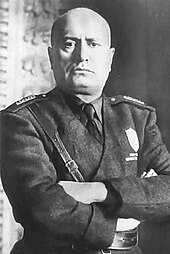
Mu 1914, Benito Mussolini wakacimbizgika mu chipani ca Italian Socialist Party cifukwa cakuti wakacema Italy kuti wanjire mu nkhondo na Austria-Hungary. Pambere Nkhondo Yakwamba ya Caru Cose yindambe, Mussolini wakasuskanga kujilemba usilikari, wakasuskanga umo Italy wakawuskiranga Libya, ndipo wakaŵa mulembi wa nyuzipepara ya Socialist Party, Avanti!, kweni pamanyuma pake wakacemerezga kuti paŵe kusintha kwambura kuzunura nkhondo ya magulu. Mu 1914, Mussolini wakasanga ndalama ku Ansaldo (kampani yakupanga vilwero) na makampani ghanyake kuti wapange nyuzipepara yake, Il Popolo d'Italia. Ŵasilikari ŵa vyaru vinyake ŵakakhumbanga kuti Italy wanjire mu nkhondo. Pamanyuma, nkhondo yikati yamara, buku ili likazgoka nyuzipepara yakuzomerezgeka na boma. Mu nyengo ya nkhondo, Mussolini wakateŵetera mu ŵasilikari ndipo wakapwetekeka kamoza.
Nkhondo yikati yamara na phangano la Versailles mu 1919, Mussolini wakambiska wupu wakuchemeka Combat League. Pakwamba, ŵanthu awo ŵakalondezganga fundo za chipani cha Socialist Party ŵakasuskanga fundo za chipani ichi. Mu nyengo yakwambilira, gulu ili likaŵa na pulogiramu yakutemwera kumazere, ilo likayowoyerathu kuti kuzamuŵa kusintha kwa ndyali, ŵanakazi ŵazamunjira mu maungano, kuzamuŵa wanangwa wa kusankha (kanyengo kanyake mu 1925) kweniso kuti katundu wa ŵanthu wose wazamupambana. Ŵakapambanaso na Ŵasilikari ŵaciŵiri aŵa cifukwa ŵakasuskanga boma lakuyuzga ŵanthu. Mussolini wakati "tikutemwa wanangwa wa waliyose, nanga ni wa ŵalwani ŵithu". Pa 15 Epulero, 1919, Ŵafarisi ŵakamba nkhaza za ndyali apo gulu la ŵanthu ŵa mu gulu la Fasci di Combattimento likapoka ofesi ya Avanti!.

Pa nyengo yeneyiyo, nyengo iyo yikamanyikwanga kuti Biennio Rosso (vyaka viŵiri vyakuthwa) yikacitika mu vilimika viŵiri vyati vyalondezga Nkhondo Yakwamba ya Caru Cose mu nyengo ya suzgo la vya cuma, kusoŵa nchito kwa ŵanthu ŵanandi, na kuleka kukhazikika kwa ndyali. Mu 1919-1920, ŵanthu ŵanandi ŵakamba kulimbana na ŵamalonda, ŵantchito ŵakachitanga viyezgelero, kweniso ŵakachitanga viyezgo kuti ŵajikorenge. Ku Turin na Milan, mabungwe gha ŵantchito ghakaŵako ndipo ŵantchito ŵanandi ŵakagwira nchito mu mafakitale. Kuwukira uku kukasazgikira ku vigaŵa vya minda ya mu Padan ndipo kukaŵa na viwawa vya ŵanthu ŵa ku mizi, viwawa vya ku mizi, na nkhondo za ŵasilikari pakati pa ŵasilikari ŵa ku mphepo na ŵa ku mphepo.
Kufuma nyengo yira, gulu la Fasci di Combattimento la Benito Mussolini likagwiliskira nchito makora fundo za ŵanthu ŵa ku Italy na kukhumba kuti vinthu viŵe makora mu caru. Mu 1920, nduna yikuru Giolitti yikasankhikaso kuti yiwovwirepo pa suzgo ilo likaŵa mu Italy, kweni nduna yake yikaŵa yambura nkhongono ndipo yikaŵa pangozi chifukwa cha ŵakususka ŵa chipani cha Socialist. Giolitti wakagomezganga kuti Ŵachifasita ŵangakanizgika ndipo ŵangaŵawovwira kuvikilira ufumu ku ŵasilikari. Mu 1921, Ŵafarisi ŵakatonda yayi, kweni boma la Giolitti likathera yayi kuwunganya ŵanthu ŵanandi kuti ŵalongozge. Ŵasilikari ŵa Fascist ŵakakana ivyo Giolitti wakaŵaphalira ndipo ŵakakolerana na ŵasilikari ŵanyake kuti ŵathereske boma lake.[67]

Mu Okutobala 1922, Mussolini wakapharazga kuti boma la Italy lipelekenge mazaza ku chipani cha Fascist. Nangauli pakaŵavya uyo wakazomera, kweni gulu la ŵanthu 30,000 ŵakamba ulendo utali kujumpha mu Italy kuluta ku Roma (March on Rome). Ŵafarisi ŵakakhumbanga kuti Luigi Facta, uyo wakaŵa nduna yikuru wa boma ili, wafumeko pa udindo wake.
Nangauli ŵasilikari ŵa Italy ŵakaŵa na vilwero viwemi comene kuluska ŵasilikari ŵa Fascist, kweni boma la Italy na Themba Victor Emmanuel III ŵakaŵa mu suzgo yikuru. Themba likakhumbikwiranga kusankhapo gulu limoza pakati pa magulu ghaŵiri agho ghakaŵa pa mphindano mu Italy ilo likate lilongozgenge boma. Wakasankha Ŵafasisi.

Wakati waŵa na mazaza, Mussolini wakakolerana na ŵanthu ŵakutemwa caru na ŵakutemwa vya wanangwa. Mu 1923, muwuso wa Mussolini ukazomerezga dango la Acerbo, ilo likapeleka vigaŵa viŵiri pa vigaŵa vitatu vya mipando ku chipani icho chikapokera mavoti 25. Chipani cha Fascist chikagwiliskira ntchito nkhaza na kofya ŵanthu kuti chiŵe na mazaza pa maungano gha mu 1924. Mubali Giacomo Matteotti, uyo wakaŵa mu chipani cha Socialist, wakakomeka wati wapempha kuti mavoti ghaleke kuchitika cifukwa ca vinthu vyambura kwenelera. Ŵalongozgi ŵa chipani ichi ŵakakolerana na ivyo vikachitika.
Mu vilimika vinayi vyakulondezgapo, Mussolini wakawuskapo vinthu vyose ivyo vikakanizganga mazaza ghake. Pa Disembala 24, 1925, wakalemba dango ilo likati ndiyo yekha wakeneranga kulongozga mu nyumba ya ufumu. Maboma gha vigaŵa ghakalekeka, ndipo ŵalara ŵa boma (awo ŵakachemekanga kuti "Podestà") ŵakamba kulamulira m'malo mwa ŵeneco. Mu 1928, magulu ghose gha ndyali ghakakanizgika, ndipo maungano gha boma ghakasintha na maungano gha ŵanthu wose.
Christopher Duggan, wakugwiliskira nchito mabuku ghake na makalata, kweniso maofesi gha ŵapolisi, ndipo wakuti Mussolini wakaŵa na ŵanthu ŵanandi awo ŵakamovwira. Mussolini wakawuska ŵanthu ŵanandi awo ŵakamususka mu Italy, ndipo wakalutilira kutchuka nangauli ŵasilikari ŵakamususka mu 1940. Duggan wakati muwuso wake ukagwiliskira ntchito makora mazaza gha Mussolini ndipo ukapangiska kuti ŵanthu ŵaŵe na nkharo yiwemi.[68]
In summary, historian Stanley G. Payne says that Fascism in Italy was:
- A primarily political dictatorship. The Fascist Party itself had become almost completely bureaucratized and subservient to, not dominant over, the state itself. Big business, industry, and finance retained extensive autonomy, particularly in the early years. The armed forces also enjoyed considerable autonomy. ... The Fascist militia was placed under military control. The judicial system was left largely intact and relatively autonomous as well. The police continued to be directed by state officials and were not taken over by party leaders, nor was a major new police elite created. There was never any question of bringing the Church under overall subservience. Sizable sectors of Italian cultural life retained extensive autonomy, and no major state propaganda-and-culture ministry existed. The Mussolini regime was neither especially sanguinary nor particularly repressive.[69]
End of the Roman question
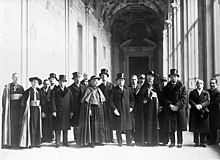
Wakati waŵa na mazaza, Mussolini wakakolerana na ŵanthu ŵakutemwa caru na ŵakutemwa vya wanangwa. Mu 1923, muwuso wa Mussolini ukazomerezga dango la Acerbo, ilo likapeleka vigaŵa viŵiri pa vigaŵa vitatu vya mipando ku chipani icho chikapokera mavoti 25. Chipani cha Fascist chikagwiliskira ntchito nkhaza na kofya ŵanthu kuti chiŵe na mazaza pa maungano gha mu 1924. Mubali Giacomo Matteotti, uyo wakaŵa mu chipani cha Socialist, wakakomeka wati wapempha kuti mavoti ghaleke kuchitika cifukwa ca vinthu vyambura kwenelera. Ŵalongozgi ŵa chipani ichi ŵakakolerana na ivyo vikachitika.
Mu vilimika vinayi vyakulondezgapo, Mussolini wakawuskapo vinthu vyose ivyo vikakanizganga mazaza ghake. Pa Disembala 24, 1925, wakalemba dango ilo likati ndiyo yekha wakeneranga kulongozga mu nyumba ya ufumu. Maboma gha vigaŵa ghakalekeka, ndipo ŵalara ŵa boma (awo ŵakachemekanga kuti "Podestà") ŵakamba kulamulira m'malo mwa ŵeneco. Mu 1928, magulu ghose gha ndyali ghakakanizgika, ndipo maungano gha boma ghakasintha na maungano gha ŵanthu wose.
Christopher Duggan, wakugwiliskira nchito mabuku ghake na makalata, kweniso maofesi gha ŵapolisi, ndipo wakuti Mussolini wakaŵa na ŵanthu ŵanandi awo ŵakamovwira. Mussolini wakawuska ŵanthu ŵanandi awo ŵakamususka mu Italy, ndipo wakalutilira kutchuka nangauli ŵasilikari ŵakamususka mu 1940. Duggan wakati muwuso wake ukagwiliskira ntchito makora mazaza gha Mussolini ndipo ukapangiska kuti ŵanthu ŵaŵe na nkharo yiwemi.[70]
Foreign politics
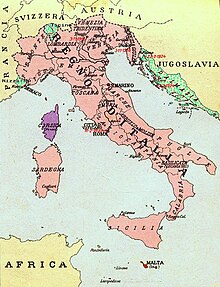
Lee wakalongosora fundo zikuruzikuru zitatu za Mussolini. Cakwamba cikaŵa kulondezga fundo za ndyali za boma la Liberal. Ku Italy kukaŵa ŵanthu awo ŵakakhumbanga kuti vinthu viŵe makora mu vyaru vya Balkan na kumpoto kwa Africa. Kufuma waka apo ŵakathereskekera ku Ethiopia mu 1896, ŵanthu ŵakakhumbanga kuti ŵatore charu ichi. Caciŵiri nchakuti ŵakakhuŵara comene cifukwa ca nyifwa ya ŵanthu ŵanandi mu Nkhondo Yakwamba ya Caru Cose. Vyaru vinyake, comenecomene Poland na Yugoslavia, vikapokera vinandi comene, ndipo Italy yikajiwona kuti yacita upusikizgi. Cacitatu, Mussolini wakalayizga kuti wawezgerengepo ufumu wakale wa Roma.
Chisopa cha ku Italy icho chikuchemeka Fascism chikukolerana na chisopa cha ku Italy ndipo chikukhumba kumalizga mulimo wa Risorgimento. Ku chigaŵa cha kumafumiro gha dazi kwa Italy, Ŵafarisi ŵakatenge Dalmatia ni charu cha ŵanthu ŵa ku Italy, ndipo ŵanthu ŵa ku Italy, kusazgapo awo ŵakaŵa ŵa ku South Slavic, ŵakachimbizgika mu Dalmatia na kuluta ku wuzga ku Italy. Mussolini wakamanya kuti Dalmatia wakaŵa na mitheto ya ku Italy kwa vyaka vinandi, nga umo vikaŵira na Istria, kwizira mu Ufumu wa Roma na Republic of Venice. Kumwera kwa Italy, Ŵasilikari ŵa Fashisti ŵakatenge caru ca Malta, ico cikaŵa ca Britain, na Corfu, ico cikaŵa ca Greece, kumpoto ŵakatenge ni Switzerland, ndipo kumanjiliro gha dazi ŵakatenge ni Corsica, Nice na Savoy, ivyo vikaŵa vya France. Boma la Fascist likalemba mabuku ghakulongosora vya caru ca Corsica. Boma la Nazi likalemba mabuku ghakulongosora vya msumba wa Nice, agho ghakalongosoranga kuti msumba uwu ukaŵa wa ku Italy cifukwa ca mbiri yake, mtundu wake, na ciyowoyero cake.[71]
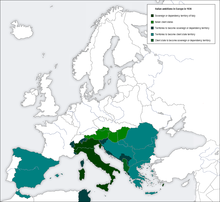
Legend:██ Metropolitan Italy and dependent territories;██ Client states;██ Claimed territories to be annexed;██ Territories to be transformed into client states. Albania, which was a client state, was considered a territory to be annexed.
Mussolini wakalayizga kuti wazamuwezgerapo ufumu wa Italy kuŵa wankhongono comene mu Europe, kuzengaso "Ufumu wa Ŵaroma" na kuwusa pa Nyanja ya Meditereniyani. Pakupharazga, Ŵafarisi ŵakagwiliskiranga nchito mazgu gha Ŵaroma ghakuti "Mare Nostrum" (Cilatini, "Nyanja Yithu") pakulongosora nyanja ya Mediterranean. Pa cifukwa ici, muwuso wa Ŵafasisi ukacitanga ndyali za ku Europe. Mu 1923, caru ca Greece ca Corfu cikapokeka na Italy pamanyuma pakuti Tellini wakomeka. Mu 1925, Albania wakakhwaskika comene na caru ca Italy cifukwa ca phangano la Tirana. Kweni vinthu vikaŵa makora yayi ku France. Boma la Nazi likakhumbanga kuwina vigaŵa vya France ivyo vikaŵa na ŵanthu ŵa ku Italy. Apo muwuso wa Nazi ukakuranga, boma la Italy likamba kufipa mtima comene na umo boma la Germany lingakhwaskira caru ici. Cifukwa ca kwenjerwa cifukwa ca kupanikizgika kwa caru ca Germany, caru ca Italy cikakolerana na France na United Kingdom mu Stresa Front, iyo yikaŵako mu 1935 m'paka 1936. Boma la Nazi likalutilira kukhumba Dalmatia, ntheura likalutilira kutinkha Yugoslavia.
Mu nyengo ya Nkhondo ya Caru na Caru ya ku Spain, iyo yikacitika pakati pa ŵasilikari ŵa chipani ca Socialist Republicans na Nationalists awo ŵakalongozgekanga na Francisco Franco, caru ca Italy cikatuma vilwero na ŵasilikari ŵakujumpha 60,000 kuti ŵawovwire ŵasilikari ŵa chipani ici. Ivi vikawovwira kuti ŵasilikari ŵa ku Italy ŵanjire mu virwa vya ku Spain. Gulu la ŵasilikari ŵa ku Italy likaponyapo sitima za nkhondo na vyakuponyera maji 91. Kweniso, ŵasilikari ŵa ku Spain ŵakatimba ngalaŵa za Republican 48 na 44 za ŵamalonda ŵakufuma ku vyaru vinyake.[72]
During all the 1930s, Italy strongly pursued a policy of naval rearmament; by 1940, the Regia Marina was the fourth largest navy in the world.
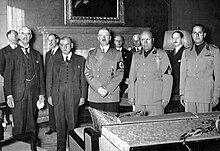
Mussolini na Adolf Hitler ŵakakumana kakwamba mu Juni 1934, apo nkhani ya kujiyimira paŵekha ya Austria yikaŵa mu suzgo. Mussolini wakakhumbanga kuti Nazi Germany yileke kuŵa na mazaza pa caru ca Europe. Kuti ivi vichitike, wakalimbana na ivyo boma la Germany likakhumbanga kuchita kuti likore charu cha Austria pamanyuma pa kukoma Engelbert Dollfuss. Nyengo zose ŵanthu ŵakalongoranga kuti Mussolini na Hitler ŵakaŵa paubwezi wakukhora, kweniso kuti visopa vyautesi vya ku Italy vikaŵa vyakuyana na vya ku Germany. Nangauli visambizgo vyose viŵiri vikaŵa vyakuyana, kweni wose ŵakakanizgana, ndipo ŵalongozgi wose ŵaŵiri ŵakakwesananga kuti ŵaŵe na mazaza pa caru cose.
Mu 1935, Mussolini wakakhumbanga kuwukira Ethiopia; Ŵaitaliya 2,313 na Ŵaetiyopiya 275,000 ŵakafwa. Nkhondo Yachiŵiri ya ku Italy na Ethiopia yikapangiska kuti caru ca Italy ciŵe cambura kukolerana na vyaru vinyake, cifukwa cakuti France na Britain vikathera luŵiro kwa Mussolini. Boma la Nazi likaŵa ilo likawovwira Italy. Pamasinda pakuti wupu wa League of Nations wamususka, Italy wakafumamo mu wupu uwu pa Disembala 11, 1937, ndipo Mussolini wakati wupu uwu ni "malo ghakusoperapo". Pa nyengo iyi, Mussolini wakaŵa na mwaŵi yayi wa kwendera lumoza na Hitler pa nkhani za ndyali, ntheura wakaleka kukhozgera boma la Austria. Mu 1938, Hitler wakambiska nkhondo yakucemeka Anschluss. Nyengo yikati yajumphapo, Mussolini wakakhozgera fundo za ku Germany pa nkhani ya Sudetenland, cigaŵa ca Czechoslovakia ico cikakhalanga ŵanthu ŵanandi ŵa ku Germany. Mu 1938, Mussolini wakawovwira kuti mu Italy ŵaŵike malango ghakususkana na Ŵayuda. Mu Malichi 1939, Germany yikati yapoka Czechoslovakia, Mussolini wakawukira Albania cifukwa cakuti wakawopanga kuti ŵanthu ŵamuwonenge nga ni muwuso waciŵiri wa ŵasilikari ŵa Axis. Pa Epulero 7, 1939, Italy yikawukira Albania na kuzgora charu ichi kuŵa chigaŵa cha Italy.
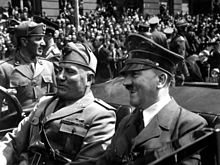
As war approached in 1939, the Fascist regime stepped up an aggressive press campaign against France claiming that Italian people were suffering in France. This was important to the alliance as both regimes mutually had claims on France, Germany on German-populated Alsace-Lorraine and Italy on the mixed Italian and French populated Nice and Corsica. In May 1939, a formal alliance with Germany was signed, known as the Pact of Steel. Mussolini felt obliged to sign the pact in spite of his own concerns that Italy could not fight a war in the near future. This obligation grew from his promises to Italians that he would build an empire for them and from his personal desire to not allow Hitler to become the dominant leader in Europe. Mussolini was repulsed by the Molotov–Ribbentrop Pact agreement where Germany and the Soviet Union agreed to partition the Second Polish Republic into German and Soviet zones for an impending invasion. The Fascist government saw this as a betrayal of the Anti-Comintern Pact, but decided to remain officially silent.[73]
World War II and fall of Fascism
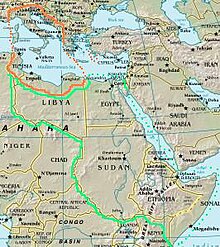
Apo boma la Germany likapoka Poland pa Seputembala 1, 1939, ndipo Nkhondo Yachiŵiri ya Caru Cose yikamba, Mussolini wakasankha kuleka kurwa nkhondo, nangauli wakayowoya kuti wakovwira Hitler. Pakunozga vyakuti ŵarwe nkhondo, Mussolini na boma la Fascist ŵakaghanaghana kuti caru ca Italy ciŵe na vigaŵa vikuruvikuru vya Africa na Middle East kuti viŵe mu ufumu wawo. Themba na mulongozgi wa ŵasilikari, Pietro Badoglio, ŵakalutilira kukayikira, ndipo ŵakachenjezga Mussolini kuti caru ca Italy cilije magaleta ghakurughakuru, vilwero vya nkhondo, na ndege zakukwana nkhondo yitali. Mussolini na boma la Nazi ŵakalondezga ulongozgi uwu, ndipo ŵakalindilira mpaka apo Germany yikawukira France mu Juni 1940 (Nkhondo ya ku France) pambere ŵandambe kunjilirapo.
Cifukwa cakuti kutondeka kwa caru ca France kukaŵa kwakuwonekerathu, Italy wakanjira mu nkhondo pa Juni 10, 1940, kufiska ivyo wakalayizga ku Wupu wa Steel. Mussolini wakaghanaghana kuti wapoke luŵiro Savoy, Nice, Corsica, na vyaru vya ku Africa nga ni Tunisia na Algeria ku Ŵafulentshi, kweni Germany wakalembapo phangano la kuleka nkhondo (22 June: Second Armistice at Compiègne) na Marshal Philippe Pétain. Ici cikakwiyiska boma la Nazi. Mu cihanya ca 1940, Mussolini wakalangura kuti ŵaponye mabomba pa caru ca Palestina na kupoka caru ca British Somaliland. Mu Seputembala, wakalangura kuti ŵanjire mu Eguputo; nangauli pakwamba vinthu vikenda makora, kweni ŵasilikari ŵa ku Italy ŵakachimbizgika na Ŵanandi (wonani Operation Compass). Hitler wakeneranga kunjilirapo na kutuma ŵasilikari ŵa Afrika Corps ŵa Jenerale Erwin Rommel, awo ŵakaŵa na mazaza pa nkhondo ya ku North Africa. Pa Okutobala 28, Mussolini wakawukira Greece kwambura kufumba Hitler, uyo wakapulika vya nkhondo ya ku Greece na Italy cifukwa ca kuŵazga mu nyuzipepara ya mulenji. Mussolini wakayezga kukhozga mubwezi wake mwa kuyowoya kuti waŵenge ku Athens mu masabata ghaŵiri kufuma apo Greece yikaparanyikira. Ndipouli, ŵasilikari ŵa Royal Air Force ŵakakanizga ŵasilikari ŵa Italy kuti ŵanjire mu Albania.
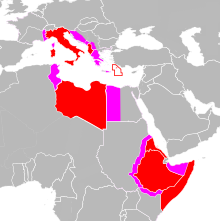
Hitler wakawovwira Mussolini apo wakawukira Ŵagiriki kufuma ku Balkan. Nkhondo ya ku Balkans iyo yikapangiska kuti Yugoslavia yidumulike na kuthereskeka kwa Greece. Pa nyengo iyi, Italy wakapoka vyaru vya kumwera kwa Slovenia, Dalmatia, Montenegro, na kukhazikiska vyaru vya Croatia na Greece. Kuzakafika mu 1942, caru ici cikaŵa pa ngozi cifukwa cakuti cuma cake cikaleka kusintha cifukwa ca nkhondo, ndipo misumba ya ku Italy yikaponyekanga mabomba na ŵasilikari ŵa ŵasilikari awo ŵakakolerananga nawo. Kweniso, nangauli Rommel wakacitanga vinthu vinandi, kweni nkhondo ya ku North Africa yikamba kutondeka kuumaliro wa 1942. Ŵakati ŵathereskeka pa nkhondo ya El Alamein, caru cikamara.
Kuzakafika mu 1943, caru ca Italy cikaŵa kuti cikutondeka pa vigaŵa vyose. Mu Janyuwale wa chaka chenechicho, hafu ya ŵasilikari ŵa ku Italy awo ŵakarwanga nkhondo mu Soviet Union ŵakakomeka, nkhondo ya ku Africa yikatondeka, caru ca Balkan cikalutilira kuŵa cambura kukhazikika, ndipo Ŵataliyana ŵakakhumbanga kuti nkhondo yimare. Mu Julayi 1943, ŵasilikari ŵa vyaru vinyake ŵakanjira mu Sicily kuti ŵathereske Italy ku nkhondo. Pa Julayi 25, Mussolini wakathereskeka na wupu wa Great Council of Fascism ndipo wakakakika na themba Victor Emmanuel III, uyo wakasora Jenerale Pietro Badoglio kuŵa nduna yikuru. Badoglio wakawuskapo vigaŵa vyaumaliro vya muwuso wa Fascist mwa kukanizga chipani cha National Fascist Party, ndipo wakalemba phangano la kuleka nkhondo na ŵasilikari ŵa ŵasilikari.[74]

Donald Detwiler notes that "Italy's entrance into the war showed very early that her military strength was only a hollow shell. Italy's military failures against France, Greece, Yugoslavia and in the African Theatres of war shook Italy's new prestige mightily."[75] Historians have long debated why Italy's military and its Fascist regime were so remarkably ineffective at an activity – war – that was central to their identity. MacGregor Knox says the explanation, "was first and foremost a failure of Italy's military culture and military institutions."[76] Norman Polmar and Thomas B. Allen argue that "the Regia Aeronautica failed to perform effectively in modern conflict. Although the Italian Air Force had been in action in the conquest of Ethiopia and the Spanish Civil War, it was totally unprepared for combat...in June 1940. At the time Italy had about 2,500 military aircraft in service. Only 11,000 more were produced during the next three years, far fewer than any of the other major belligerents."[77] James Sadkovich gives the most charitable interpretation of Italian failures, blaming inferior equipment, overextension, and inter-service rivalries. Its forces had "more than their share of handicaps."[78]

About Italian troops in El Alamein, Italian Defence ministry chief of staff Luigi Binelli Mantelli said: "The spirit of service and cohesion are fundamental elements for the operational capacity of the armed forces ... The (Folgore) Paratroopers have always shown this. El Alamein was a battle that was lost with great honour, facing up to overwhelmingly superior firepower with poor weapons but with great spirit and capacity to resist and to hold up high the honour of Italy".[79] British historian John Bierman said that the Italian tank regiment "fought with great audacity, just as the Ariete artillery regiment did". According to American historian John W. Gordon, the British special forces were so impressed by the methods and tactics of the Italian desert corps "that they actually copied them".[79] German General Erwin Rommel praised the Italians on several occasions, describing their as "extraordinary, courageous, disciplined, but badly commanded and equipped."[80] Writing about the fighting at the First Battle of El Alamein, he stated: "The Italians were willing, unselfish and good comrades in the frontline. There can be no disputing that the achievement of all the Italian units, especially the motorised elements, far outstripped any action of the Italian Army for 100 years. Many Italian generals and officers earned our respect as men as well as soldiers".[81] During the Second Battle of El Alamein the 7th Bersaglieri Regiment exhibited a strong regimental spirit in the fight for Hill 28 that impressed Rommel to comment positively.[82] On a plaque dedicated to the Bersaglieri that fought at Mersa Matruh and Alamein, Rommel wrote: "The German soldier has impressed the world; the Italian Bersagliere has impressed the German soldier."[83]
Civil War, Allied advance, and Liberation
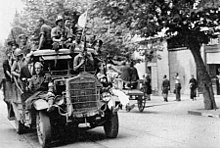
Although other European countries such as Norway, the Netherlands, and France also had partisan movements and collaborationist governments with Nazi Germany, armed confrontation between compatriots was most intense in Italy, making the Italian case unique.[84] In 1965, the definition of "civil war" was used for the first time by fascist politician and historian Giorgio Pisanò in his books,[85][86] while Claudio Pavone's book Una guerra civile. Saggio storico sulla moralità della Resistenza (A Civil War. Historical Essay On the Morality Of the Resistance), published in 1991, led to the term "Italian Civil War" being used more frequently by Italian[nb 2] and international[87][88] historiography.

Soon after being ousted, Mussolini was rescued by a German commando in Operation Eiche ("Oak"). The Germans brought Mussolini to northern Italy where he set up a Fascist puppet state, the Italian Social Republic (RSI). Meanwhile, the Allies advanced in southern Italy. In September 1943, Naples rose against the occupying German forces. The Allies organized some royalist Italian troops into the Italian Co-Belligerent Army, while other troops continued to fight alongside Nazi Germany in the Esercito Nazionale Repubblicano, the National Republican Army. In addition, a large Italian resistance movement started a long guerrilla war against the German and Fascist forces. As a consequence, the country descended into civil war, with the Italian Co-belligerent Army and the resistance movement, supported by the Allies, contended the Social Republic's forces and its German allies. The Germans, often helped by Fascists, committed several atrocities against Italian civilians in occupied zones, such as the Ardeatine massacre and the Sant'Anna di Stazzema massacre. The Kingdom of Italy declared war on Nazi Germany on 13 October 1943;[89][90] tensions between the Axis Powers and the Italian military were rising following the failure to defend Sicily, with New York Times correspondent Milton Bracker noting that "Italian hatred of the Germans unquestionably grew as the fighting spirit waned, and episodes between German and Italian soldiers and civilians before and after the armistice have shown pretty clearly a complete and incontrovertible end of all sympathy between the former Axis partners."[89]
On 16 October, the Rastenburg Protocol was signed with Nazi Germany. In accordance with this protocol, the RSI was allowed to raise division-sized military formations. This allowed Graziani to raise four RSI divisions totalling 52,000 men. In July 1944, the first of these divisions completed training and was sent to the front. Recruiting military forces was difficult for the RSI, as most of the Italian army had been interned by German forces in 1943, many Italians had been conscripted into forced labour in Germany and few wanted to fight on Nazi Germany's side after 8 September 1943. The RSI became so desperate for soldiers that it granted convicts freedom if they would join the army and the sentence of death was imposed on anyone who opposed being conscripted.[91] Autonomous military forces in the RSI also fought against the Allies including the notorious Decima Flottiglia MAS under command of Prince Junio Valerio Borghese. Borghese held no allegiance to Mussolini and even suggested that he would take him prisoner if he could.[91]
On 4 June 1944, the German occupation of Rome came to an end as the Allies advanced. As the Allies advanced north, they encountered increasingly difficult terrain, as mountains offered excellent defensive positions to Axis forces. The final Allied victory over the Axis in Italy did not come until the spring offensive of 1945, after Allied troops had breached the Gothic Line, leading to the surrender of German and Fascist forces in Italy on 2 May shortly before Germany finally surrendered ending World War II in Europe on 8 May. It is estimated that between September 1943 and April 1945, some 60,000 Allied and 50,000 German soldiers died in Italy.[nb 3]

During World War II, Italian war crimes included extrajudicial killings and ethnic cleansing[93] by the deportation of about 25,000 people, mainly Jews, Croats, and Slovenians, to the Italian concentration camps, such as Rab, Gonars, Monigo, Renicci di Anghiari and elsewhere. Yugoslav Partisans perpetrated their own crimes against the local ethnic Italian population (Istrian Italians and Dalmatian Italians) during and after the war, including the foibe massacres. In Italy and Yugoslavia, unlike in Germany, few war crimes were prosecuted.[94][95][96][97]
On 25 April 1945 the National Liberation Committee for Northern Italy proclaimed a general insurrection in all the territories still occupied by the Nazi-fascists, indicating to all the partisan forces active in Northern Italy that were part of the Volunteer Corps of Freedom to attack the fascist and German garrisons by imposing the surrender, days before the arrival of the Allied troops; at the same time, the National Liberation Committee for Northern Italy personally issued legislative decrees,[98] assuming power "in the name of the Italian people and as a delegate of the Italian Government", establishing among other things the death sentence for all fascist hierarchs,[99] "Surrender or die!" was the rallying call of the partisans that day and those immediately following. Today the event is commemorated in Italy every 25 April by the Liberation Day, National Day introduced on 22 April 1946, which celebrates the liberation of the country from fascism.[100]
Mussolini was captured on 27 April 1945, by communist Italian partisans near the Swiss border as he tried to escape Italy. On the next day, he was executed for high treason, as sentenced in absentia by a tribunal of the CLN. Afterwards, the bodies of Mussolini, his mistress, and about fifteen other Fascists were taken to Milan where they were displayed to the public. Days later on 2 May 1945, the German forces in Italy surrendered. The government of Badoglio had remained in being for some nine months. On 9 June 1944, he was replaced as Prime Minister by the 70-year-old anti-fascist leader Ivanoe Bonomi. In June 1945 Bonomi was in turn replaced by Ferruccio Parri, who in turn gave way to Alcide de Gasperi on 4 December 1945. Finally, De Gasperi supervised the transition to a Republic following the abdication of Vittorio Emanuele III on 9 May 1946, the one-month-long reign of his son Umberto II ("King of May") and the Constitutional Referendum that abolished the monarchy; De Gasperi briefly became acting Head of State as well as Prime Minister on 18 June 1946, but ceded the former role to Provisional President Enrico de Nicola ten days later.
Anti-fascism against Mussolini's regime
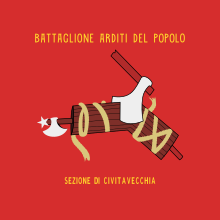
In Italy, Mussolini's Fascist regime used the term anti-fascist to describe its opponents. Mussolini's secret police was officially known as the Organization for Vigilance and Repression of Anti-Fascism. During the 1920s in the Kingdom of Italy, anti-fascists, many of them from the labor movement, fought against the violent Blackshirts and against the rise of the fascist leader Benito Mussolini. After the Italian Socialist Party (PSI) signed a pacification pact with Mussolini and his Fasces of Combat on 3 August 1921,[101] and trade unions adopted a legalist and pacified strategy, members of the workers' movement who disagreed with this strategy formed Arditi del Popolo.[102]
The Italian General Confederation of Labour (CGL) and the PSI refused to officially recognize the anti-fascist militia and maintained a non-violent, legalist strategy, while the Communist Party of Italy (PCd'I) ordered its members to quit the organization. The PCd'I organized some militant groups, but their actions were relatively minor.[103] The Italian anarchist Severino Di Giovanni, who exiled himself to Argentina following the 1922 March on Rome, organized several bombings against the Italian fascist community.[104] The Italian liberal anti-fascist Benedetto Croce wrote his Manifesto of the Anti-Fascist Intellectuals, which was published in 1925.[105][page needed] Other notable Italian liberal anti-fascists around that time were Piero Gobetti and Carlo Rosselli.[106]
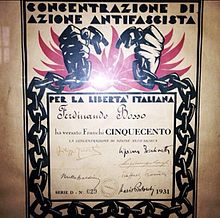
Concentrazione Antifascista Italiana (English: Italian Anti-Fascist Concentration), officially known as Concentrazione d'Azione Antifascista (Anti-Fascist Action Concentration), was an Italian coalition of Anti-Fascist groups which existed from 1927 to 1934. Founded in Nérac, France, by expatriate Italians, the CAI was an alliance of non-communist anti-fascist forces (republican, socialist, nationalist) trying to promote and to coordinate expatriate actions to fight fascism in Italy; they published a propaganda paper entitled La Libertà.[107][108][109]

Giustizia e Libertà (English: Justice and Freedom) was an Italian anti-fascist resistance movement, active from 1929 to 1945.[110] The movement was cofounded by Carlo Rosselli,[110] Ferruccio Parri, who later became Prime Minister of Italy, and Sandro Pertini, who became President of Italy, were among the movement's leaders.[111] The movement's members held various political beliefs but shared a belief in active, effective opposition to fascism, compared to the older Italian anti-fascist parties. Giustizia e Libertà also made the international community aware of the realities of fascism in Italy, thanks to the work of Gaetano Salvemini.
Many Italian anti-fascists participated in the Spanish Civil War with the hope of setting an example of armed resistance to Franco's dictatorship against Mussolini's regime; hence their motto: "Today in Spain, tomorrow in Italy".[112]
Between 1920 and 1943, several anti-fascist movements were active among the Slovenes and Croats in the territories annexed to Italy after World War I, known as the Julian March.[113][114] The most influential was the militant insurgent organization TIGR, which carried out numerous sabotages, as well as attacks on representatives of the Fascist Party and the military.[115][116] Most of the underground structure of the organization was discovered and dismantled by the Organization for Vigilance and Repression of Anti-Fascism (OVRA) in 1940 and 1941,[117] and after June 1941 most of its former activists joined the Slovene Partisans.
During World War II, many members of the Italian resistance left their homes and went to live in the mountains, fighting against Italian fascists and German Nazi soldiers during the Italian Civil War. Many cities in Italy, including Turin, Naples and Milan, were freed by anti-fascist uprisings.[118]
Republican era (1946–present)
Birth of the Republic

Much like Japan and Germany, the aftermath of World War II left Italy with a destroyed economy, a divided society, and anger against the monarchy for its endorsement of the Fascist regime for the previous twenty years. These frustrations contributed to a revival of the Italian republican movement.[119] Following Victor Emmanuel III's abdication, his son, the new king Umberto II, was pressured by the threat of another civil war to call a Constitutional Referendum to decide whether Italy should remain a monarchy or become a republic. On 2 June 1946, the republican side won 54% of the vote and Italy officially became a republic. All male members of the House of Savoy were barred from entering Italy, a ban which was only repealed in 2002.
Under the Treaty of Peace with Italy, 1947, Istria, Kvarner, most of the Julian March as well as the Dalmatian city of Zara was annexed by Yugoslavia causing the Istrian-Dalmatian exodus, which led to the emigration of between 230,000 and 350,000 local ethnic Italians (Istrian Italians and Dalmatian Italians), the others being ethnic Slovenians, ethnic Croatians, and ethnic Istro-Romanians, choosing to maintain Italian citizenship.[120]
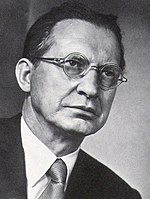
Later, the Free Territory of Trieste was divided between the two states. Italy also lost all of its colonial possessions, formally ending the Italian Empire. In 1950, Italian Somaliland was made a United Nations Trust Territory under Italian administration until 1 July 1960. The Italian border that applies today has existed since 1975, when Trieste was formally re-annexed to Italy.
The General Elections of 1946, held at the same time as the Constitutional Referendum, elected 556 members of a Constituent Assembly, of which 207 were Christian Democrats, 115 Socialists and 104 Communists. A new constitution was approved, setting up a parliamentary democracy. In 1947, under American pressure, the communists were expelled from the government. The Italian general election, 1948 saw a landslide victory for Christian Democrats, that dominated the system for the following forty years.
Marshall Plan aid from the United States
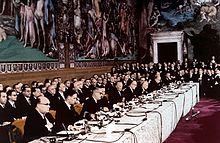
Italy joined the Marshall Plan (ERP) and NATO. By 1950, the economy had largely stabilized and started booming.[121] In 1957, Italy was a founding member of the European Economic Community, which later transformed into the European Union (EU).
The Marshall Plan's long-term legacy was to help modernize Italy's economy. How Italian society built mechanisms to adapt, translate, resist, and domesticate this challenge had a lasting effect on the nation's development over the subsequent decades.[122] After Fascism's failure, the United States offered a vision of modernization that was unprecedented in its power, internationalism, and invitation to emulation. However Stalinism was a powerful political force. The ERP was one of the main ways that this modernization was operationalized. The old prevailing vision of the country's industrial prospects had been rooted in traditional ideas of craftsmanship, frugality and thrift, which stood in contrast to the dynamism seen in automobiles and fashion, anxious to leave behind the protectionism of the Fascist era and take advantage of the opportunities offered by rapidly expanding world trade.
By 1953, industrial production had doubled compared with 1938 and the annual rate of productivity increase was 6.4%, twice the British rate. At Fiat, automobile production per employee quadrupled between 1948 and 1955, the fruit of an intense, Marshall Plan-aided application of American technology (as well as much more intense discipline on the factory-floor). Vittorio Valletta, Fiat's general manager, helped by trade barriers that blocked French and German cars, focused on technological innovations as well as an aggressive export strategy. He successfully bet on serving the more dynamic foreign markets from modern plants built with the help of Marshall Plan funds. From this export base he later sold into a growing domestic market, where Fiat was without serious competition. Fiat managed to remain at the cutting edge of car manufacturing technology, enabling it to expand production, foreign sales, and profits.[123]
Economic miracle
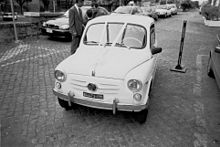
In the 1950s and 1960s the country enjoyed prolonged economic boom, which was accompanied by a dramatic rise in the standard of living of ordinary Italians.[124] The so-called Italian economic miracle lasted almost uninterruptedly until the "Hot Autumn's" massive strikes and social unrest of 1969–70, that combined with the later 1973 oil crisis, gradually cooled the economy, that has never returned to its heady post-war growth rates.
It has been calculated that the Italian economy experienced an average rate of growth of GDP of 5.8% per year between 1951 and 1963, and 5.0% per year between 1964 and 1973.[125] Italian rates of growth were second only, but very close, to the German rates, in Europe, and among the OEEC countries only Japan had been doing better.[126] Between 1955 and 1971, around 9 million people are estimated to have been involved in inter-regional migrations in Italy, uprooting entire communities.[127] Emigration was especially directed to the factories of the so-called "industrial triangle", a region encompassed between the major manufacturing centres of Milan and Turin and the seaport of Genoa.
The needs of a modernizing economy demanded new transport and energy infrastructures. Thousands of kilometres of railways and highways were completed in record times to connect the main urban areas, while dams and power plants were built all over Italy, often without regard for geological and environmental conditions. Strong urban growth led to uncontrolled urban sprawl.
The natural environment was constantly under threat by wild industrial expansion, leading to ecological disasters like the Vajont Dam inundation and the Seveso chemical accident. The boom had also a huge impact on Italian society and culture. The pervasive influence of mass media and consumerism on society has often been fiercely criticized by intellectuals like Pier Paolo Pasolini and film directors like Dino Risi, Vittorio De Sica and Ettore Scola, that stigmatized selfishness and immorality that characterized miracle's years.
Years of Lead

During the 1970s, Italy saw an unexpected escalation of political violence. From 1969 to 1980, repeated neofascist outrages were launched such as the Piazza Fontana bombing in 1969. Red Brigades and many other groups decided on armed attacks as a revolutionary strategy. They carried out urban riots, as in Rome and Bologna in 1977. Known as the Years of Lead, this period was characterised by widespread social conflicts and terrorist acts carried out by extra-parliamentary movements. The assassination of the leader of the Christian Democracy (DC), Aldo Moro, led to the end of a "historic compromise" between the DC and the Communist Party (PCI). In the 1980s, for the first time, two governments were managed by a Republican (Giovanni Spadolini 1981–82) and a Socialist (Bettino Craxi 1983–87) rather than by a Christian Democrat.[128][129]
At the end of the Lead years, the PCI gradually increased their votes thanks to Enrico Berlinguer. The Socialist Party (PSI), led by Bettino Craxi, became more and more critical of the Communists and of the Soviet Union; Craxi himself pushed in favour of US President Ronald Reagan's positioning of Pershing II missiles in Italy.
Second Republic (1992–present)
Italy faced several terror attacks between 1992 and 1993, perpetrated by the Sicilian Mafia as a consequence of several life sentences pronounced during the "Maxi Trial", and of the new anti-mafia measures launched by the government. In 1992, two major dynamite attacks killed the judges Giovanni Falcone (23 May in the Capaci bombing) and Paolo Borsellino (19 July in the Via D'Amelio bombing).[130] One year later (May–July 1993), tourist spots were attacked, such as the Via dei Georgofili in Florence, Via Palestro in Milan, and the Piazza San Giovanni in Laterano and Via San Teodoro in Rome, leaving 10 dead and 93 injured and causing severe damage to cultural heritage such as the Uffizi Gallery. The Catholic Church openly condemned the Mafia, and two churches were bombed and an anti-Mafia priest shot dead in Rome.[131][132]
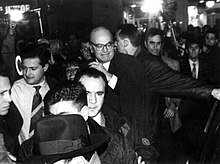
From 1992 to 1997, Italy faced significant challenges as voters disenchanted with political paralysis, massive government debt, extensive corruption, and organised crime's considerable influence collectively called the political system Tangentopoli. As Tangentopoli was under a set of judicial investigations by the name of Mani pulite (Italian for "clean hands"), voters demanded political, economic, and ethical reforms. The Tangentopoli scandals involved all major parties, but especially those in the government coalition: between 1992-94 the DC underwent a severe crisis and was dissolved, splitting up into several pieces, among whom the Italian People's Party and the Christian Democratic Center. The PSI (along with other minor governing parties) completely dissolved.[133][134]
The 1994 general election also swept media magnate Silvio Berlusconi (Leader of "Pole of Freedoms" coalition) into office as Prime Minister. Berlusconi, however, was forced to step down in December 1994 when his Lega Nord partners withdrew support. The Berlusconi government was succeeded by a technical government headed by Prime Minister Lamberto Dini, which left office in early-1996.
At the 1996 general election, Romano Prodi led a centre-left coalition to victory. Prodi's first government became the third-longest to stay in power before he narrowly lost a vote of confidence, by three votes, in October 1998. A new government was formed by Democrats of the Left leader and former Communist Massimo D'Alema, but in April 2000, following poor performance by his coalition in regional elections, D'Alema resigned.
The succeeding centre-left government, including most of the same parties, was headed by Giuliano Amato (social-democratic), who previously served as Prime Minister from 1992 to 1993 and again from April 2000 until June 2001.
That same year, a centre-right coalition formed the government and Silvio Berlusconi was able to regain power and keep it for a complete five-year mandate; becoming the longest-serving government in post-war Italy. Berlusconi participated in the US-led multinational coalition in Iraq.
The 2006 general election returned Prodi to government, leading an all-encompassing centre-left coalition of 11 parties (The Union). Prodi won with only a narrow majority in the Senate, also due to the new proportional electoral law introduced by Berlusconi and Calderoli in 2005. In the first year of his government, Prodi followed a cautious policy of economic liberalisation and reduction of public debt. His government, in loss of popularity, was anyway sacked by the end of support from centrist MPs led by Clemente Mastella.
Berlusconi won the 2008 general election, with the People of Freedom party (fusion of his previous Forza Italia party and of Fini's National Alliance) against Walter Veltroni of the Democratic Party. Italy was among the countries hit hardest by the Great Recession of 2008–09 and the subsequent European debt crisis. The national economy shrunk by 6.76% during the whole period, totalling seven quarters of recession.[135] In 2010, Berlusconi's party saw the splintering of Gianfranco Fini's new faction, which formed a parliamentary group and voted against him in a no-confidence vote on 14 December 2010. Berlusconi's government was able to avoid no-confidence thanks to support from sparse MPs, but has lost a consistent majority in the lower Chamber. In November 2011, the Italian bond yield was 6.74 per cent for 10-year bonds, nearing a 7% level where Italy is thought to lose access to financial markets.[136] On 12 November 2011, Berlusconi eventually resigned, and the famous economist Mario Monti was sworn in as Prime Minister at the head of a technocratic government. As a shock therapy to avoid the debt crisis and kick-start economic growth, Monti's national unity government launched a massive programme of austerity measures; that reduced the deficit but precipitated the country in a double-dip recession in 2012 and 2013, receiving criticism from numerous economists.[137][138]

On 24 and 25 February 2013, a general election was held; a centre-left coalition led Pier Luigi Bersani, Leader of the Democratic Party, won a slight majority in the Chamber of Deputies but did not control the Senate. The election was characterised by the surprise success of the anti-establishment Five Star Movement, founded by former comedian Beppe Grillo, which came second with 25.5% of votes. On 24 April, President Napolitano gave to the Vice-Secretary of the Democratic Party, Enrico Letta, the task of forming a government, having determined that Bersani could not form a government. Letta formed a short-lived grand coalition government, supported also by The People of Freedom of Silvio Berlusconi and Civic Choice of Mario Monti. Letta's cabinet lasted until 22 February 2014 (for a total of 300 days), as the government fell apart after the Democratic Party retired its support of Letta in favour of Matteo Renzi, the 39-year-old mayor of Florence and nicknamed "Il Rottamatore" (The scrapper), who formed a new government with the support of some centrist parties. The Cabinet was the youngest government of Italy up to date, with an average age of 47 years and the first in which the number of female ministers was equal to the number of male ministers. The government implemented numerous reforms, including changes to the electoral system, a relaxation of labour and employment laws with the intention of boosting economic growth, a thorough reformation of the public administration and the introduction of same-sex civil unions.[139] However, Renzi resigned after losing a constitutional referendum in December 2016, and was succeeded by Paolo Gentiloni. The centre-left Cabinets were plagued by the aftermath of the European debt crisis and the European migrant crisis, which fuelled support for populist and right-wing parties.[140]

The 2018 general election resulted in a hung parliament once again, which led to an unlikely populist government between the anti-establishment Five Star Movement and Salvini's Lega, led by Giuseppe Conte.[141] However, after only fourteen months, the League withdrew its support to Conte, who subsequently allied with the Democratic Party and other smaller left-wing parties to form a new Cabinet.[142][143] In 2020, Italy was severely hit by the COVID-19 pandemic.[144] From March to May 2020, Conte's government imposed a national lockdown as a measure to limit the spread of COVID-19.[145][146] The measures, despite being widely approved by public opinion,[147] were also described as the largest suppression of constitutional rights in the history of the republic.[148][149] With more than 100,000 confirmed fatalities, Italy was one of the countries with the highest total number of deaths in the worldwide coronavirus pandemic.[150] The pandemic caused also a severe economic disruption, which resulted in Italy being one of the most affected countries.[151] In February 2021, these extraordinary circumstances brought to the formation of a national coalition government led by former President of the European Central Bank Mario Draghi. On 13 February 2021, he was sworn in as Prime Minister. The Draghi cabinet had support across the broad political spectrum.[152] In January 2022, President Sergio Mattarella was re-elected to serve a second consecutive seven-year term.[153]
On 21 July 2022, following a government crisis which ended with FI, League and the M5S deciding to withdraw their support to the government, Prime Minister Draghi resigned. President Sergio Mattarella consequently dissolved the Parliament[154] and called a snap election, which resulted in the centre-right coalition gaining an absolute majority of seats.[155]
On 22 October 2022, Giorgia Meloni was sworn in as Italy's first female prime minister. Her Brothers of Italy party formed a right-wing government with the far-right League and centre-right of ex-prime minister Silvio Berlusconi's party.[156]
See also
- Duchy of Urbino
- Genetic history of Italy
- History of Capri
- History of Naples
- History of Rome
- History of Sardinia
- History of Sicily
- History of the Republic of Venice
- History of Trentino
- History of Tuscany
- History of Verona
- Kingdom of Lombardy–Venetia
- List of consorts of Montferrat
- List of consorts of Naples
- List of consorts of Savoy
- List of consorts of the Kingdom of the Two Sicilies
- List of consorts of Tuscany
- List of Italian queens
- List of Italian inventions and discoveries
- List of kings of the Lombards
- List of Milanese consorts
- List of Modenese consorts
- List of monarchs of Naples
- List of monarchs of Sardinia
- List of monarchs of Sicily
- List of monarchs of the Kingdom of the Two Sicilies
- List of Parmese consorts
- List of presidents of Italy
- List of prime ministers of Italy
- List of queens of the Lombards
- List of Roman and Byzantine Empresses
- List of rulers of Tuscany
- List of Sardinian consorts
- List of Sicilian consorts
- List of State Archives of Italy
- List of viceroys of Naples
- List of viceroys of Sicily
- Milan
- Military history of Italy
- Politics of Italy
Vyakulemba
- ↑ Although he makes many references to classical sources, these references do not include the customary deference to Aristotle which was to some extent approved by the church in his time. Strauss (1958:222) says that "Machiavelli indicates his fundamental disagreement with Aristotle's doctrine of the whole by substituting "chance" (caso) for "nature" in the only context in which he speaks of "the beginning of the world." Strauss gives evidence that Machiavelli was knowingly influenced by Democritus, whose philosophy of nature was, like that of modern science, materialist."
- ↑ See as examples Renzo De Felice and Gianni Oliva.
- ↑ In Alexander's Generals Blaxland quotes 59,151 Allied deaths between 3 September 1943 and 2 May 1945 as recorded at AFHQ and gives the breakdown between 20 nationalities: United States 20,442; United Kingdom, 18,737; France, Morocco, Algeria, Tunisia, Senegal and Belgium 5,241; Canada, 4,798; India, Pakistan, Nepal 4,078; Poland 2,028; New Zealand 1,688; Italy (excluding irregulars) 917; South Africa 800; Brazil 275; Greece 115; Jewish volunteers from the British Mandate in Palestine 32. In addition, 35 soldiers were killed by enemy action while serving with pioneer units from Botswana, Lesotho, Swaziland, Seychelles, Mauritius, Sri Lanka, Lebanon, Cyprus and the West Indies[92]
Ukaboni
- ↑ Lazenby, John Francis (1998). Hannibal's War: A Military History of the Second Punic War. University of Oklahoma Press. p. 29. ISBN 9780806130040.
Italy homeland of the Romans.
- ↑ Maddison, Angus (20 Sekutembala 2007). Contours of the World Economy 1-2030 AD: Essays in Macro-Economic History. ISBN 9780199227211.
- ↑ Sée, Henri. "Modern Capitalism Its Origin and Evolution" (PDF). University of Rennes. Batoche Books. Archived from the original (PDF) on 7 Okutobala 2013. Retrieved 29 Ogasiti 2013.
The origin and development of capitalism in Italy are illustrated by the economic life of the great city of Florence.
- ↑ Sée, Henri. "Modern Capitalism Its Origin and Evolution" (PDF). University of Rennes. Batoche Books. Archived from the original (PDF) on 7 Okutobala 2013. Retrieved 29 Ogasiti 2013.
- ↑ Smith, D. Mack (1970). Storia della Sicilia medioevale e moderna (in Italian). Bari: Laterza. pp. 27, 39, 45, 50–51, 98–108, 190–201.
- ↑ Jepson, Tim (2012). National Geographic Traveler: Italy. National Geographic Books. ISBN 9781426208614.
- ↑ Canada Among Nations, 2004: Setting Priorities Straight. McGill-Queen's Press – MQUP. 17 Janyuwale 2005. p. 85. ISBN 978-0-7735-2836-9. Retrieved 13 Juni 2016.
The United States is the sole world's superpower. France, Italy, Germany and the United Kingdom are great powers.
- ↑ Sterio, Milena (2013). The Right to Self-Determination Under International Law: "Selfistans", Secession, and the Rule of the Great Powers. Milton Park, Abingdon, Oxon: Routledge. p. xii (preface). ISBN 978-0-415-66818-7. Retrieved 13 Juni 2016.
The great powers are super-sovereign states: an exclusive club of the most powerful states economically, militarily, politically and strategically. These states include veto-wielding members of the United Nations Security Council (United States, United Kingdom, France, China, and Russia), as well as economic powerhouses such as Germany, Italy and Japan.
- ↑ "Fossil Teeth Put Humans in Europe Earlier Than Thought". The New York Times. 2 Novembala 2011.
- ↑ "Sassi di Matera". AmusingPlanet.
- ↑ One or more of the preceding sentences incorporates text from a publication now in the public domain: Mitchell, John Malcolm (1911). "Terramara". In Chisholm, Hugh (ed.). Encyclopædia Britannica (in English). Vol. 26 (11th ed.). Cambridge University Press. pp. 658–659.
- ↑ Salvatore Piccolo, cit., pp.30-31
- ↑ Ugas, Giovanni (2005). L'Alba dei Nuraghi. Cagliari: Fabula editrice. ISBN 978-88-89661-00-0.
- ↑ 14.0 14.1 Bonfante, Larissa (1986). Etruscan Life and Afterlife: A Handbook of Etruscan Studies. Wayne State University Press. p. 58. ISBN 0-8143-1813-4.
- ↑ 15.0 15.1 Franklin Hall, John (1996). Etruscan Italy: Etruscan Influences on the Civilizations of Italy from Antiquity to the Modern Era. Indiana University Press. p. 198. ISBN 0-8425-2334-0.
- ↑ 16.0 16.1 Catherine Mason, Carl Waldman. Encyclopedia of European Peoples. Infobase Publishing. pp. 452–459.
- ↑ Woodard, Roger D. (2008). "Greek dialects". The Ancient Languages of Europe. Cambridge University Press. p. 51. ISBN 978-0-521-68495-8.
- ↑ Adkins, 1998. page 3.
- ↑ Between Republic and Empire: Interpretations of Augustus and His Principate. University of California Press. p. 400.
- ↑ Livy Ep. 68
- ↑ Scullard 1982, chapters VI-VII
- ↑ [1] Plutarch, Parallel Lives, Life of Antony, LXXI, 3–5.
- ↑ Altri nomi e appellativi relazionati allo status dell'Italia in epoca romana (in Italian). Bloomsbury. 20 Novembala 2013. ISBN 9781472519801. Retrieved 20 Novembala 2021.
- ↑ "Antico appellativo dell'Italia romana: Italia Omnium Terrarum Parens" (in Italian). Retrieved 20 Novembala 2021.
- ↑ "Pax Romana". Britannica Online Encyclopedia.
- ↑ War and Religion: An Encyclopedia of Faith and Conflict [3 volumes]. ABC-CLIO. 2017. p. 113.
- ↑ Cristina La Rocca, ed. Italy in the Early Middle Ages: 476-1000 (2002).
- ↑ Holger Berwinkel, "Legnano, Battle of (1176)." in Gordon Martel ed The Encyclopedia of War (2011) ch 27.
- ↑ de Sismondi, Simonde (1968). Storia delle Repubbliche Italiane nel Medioevo (in Italian). Avanzini e Torraca Editori.
- ↑ Armando Lodolini Le repubbliche del mare, Roma, Biblioteca di storia patria, 1967.
- ↑ "The Duomo of Florence | Tripleman". tripleman.com. Archived from the original on 6 Disembala 2009. Retrieved 25 Malichi 2010.
- ↑ "Brunelleschi's Dome". Brunelleschi's Dome.com. Retrieved 25 Malichi 2010.
- ↑ Coispeau, Olivier (10 Ogasiti 2016). Finance Masters: A Brief History of International Financial Centers in the Last Millennium (in English). World Scientific. ISBN 9789813108844.
- ↑ Bireley (1990)
- ↑ Greene, George Washington (1837). The Life and Voyages of Verrazzano. Cambridge University: Folsom, Wells, and Thurston. p. 13. Retrieved 18 Ogasiti 2017 – via Google Books.
- ↑ Jensen 1992, p. 64.
- ↑ John Julius Norwich, The Italians: History, Art and the Genius of a People (1983) p 165-66.
- ↑ Carlo M. Cipolla, “The Decline of Italy: The Case of a Fully Matured Economy.” abFZxxxx Economic History Review 5#2 1952, pp. 178–187. online
- ↑ Baten, Jörg (2016). A History of the Global Economy. From 1500 to the Present. Cambridge University Press. p. 45. ISBN 9781107507180.
- ↑ Maddison, Angus (2007). Contours of the World Economy, 1–2030 AD: Essays in Macro-Economic History (1st ed.). Oxford: Oxford University Press. p. 379, table A.4. ISBN 978-0-19-922720-4.
- ↑ Alexander Grab, Napoleon and the Transformation of Europe (2003) pp 62–65, 78–79, 88–96, 115–17, 154–59
- ↑ Frederick B. Artz, Reaction and Revolution: 1814–1832 (1934) pp 142–43
- ↑ Tarozzi, Fiorenza; Vecchio, Giorgio (1999). Gli italiani e il tricolore (in Italian). Il Mulino. pp. 67–68. ISBN 88-15-07163-6.
- ↑ "Proclamation of Rimini". 1815. Archived from the original on 26 Janyuwale 2008. Retrieved 21 Febuluwale 2008.
- ↑ "Scholar and Patriot". Manchester University Press – via Google Books.
- ↑ "Giuseppe Garibaldi (Italian revolutionary)". Archived from the original on 26 Febuluwale 2014. Retrieved 6 Malichi 2014.
- ↑ Maiorino, Tarquinio; Marchetti Tricamo, Giuseppe; Zagami, Andrea (2002). Il tricolore degli italiani. Storia avventurosa della nostra bandiera (in Italian). Arnoldo Mondadori Editore. p. 18. ISBN 978-88-04-50946-2.
- ↑ Giuseppe André, Nizza negli ultimi quattro anni, Nice, Editore Gilletta, 1875, pp. 334-335 (In Italian).
- ↑ Roland Sarti, Italy: A Reference Guide from the Renaissance to the Present (2004) pp 567–568
- ↑ Pozzetta, George E. (1980). Pane e Lavoro: The Italian American Working Class. Toronto: Multicultural History Society of Ontorio.
- ↑ "Il mito della "lampada perenne"" (in Italian). Retrieved 12 Febuluwale 2018.
- ↑ Arnaldi, Girolamo. Italy and Its Invaders. Harvard University Press, 2005. p. 194. ISBN 0-674-01870-2.
- ↑ "Museo Centrale del Risorgimento di Roma". Istituto per la storia del Risorgimento italiano (in Italian). Retrieved 6 Julayi 2018.
- ↑ Bosworth, R.J.B. (2013). Italy and the Wider World: 1860–1960. Routledge. p. 29. ISBN 978-1-134-78088-4.
- ↑ Smith 1997, p. 139.
- ↑ Bosworth 2005, p. 49.
- ↑ Burgwyn, H. James (1997). Italian foreign policy in the interwar period, 1918–1940. Greenwood Publishing Group. p. 4. ISBN 0-275-94877-3.
- ↑ Schindler, John R. (2001). Isonzo: The Forgotten Sacrifice of the Great War. Greenwood Publishing Group. p. 303. ISBN 0-275-97204-6.
- ↑ Mack Smith, Denis (1982). Mussolini. Knopf. p. 31. ISBN 0-394-50694-4.
- ↑ Paoletti, Ciro (2008). A Military History of Italy. Greenwood Publishing Group. p. 150. ISBN 978-0-275-98505-9.
... Ludendorff wrote: In Vittorio Veneto, Austria did not lose a battle, but lose the war and itself, dragging Germany in its fall. Without the destructive battle of Vittorio Veneto, we would have been able, in a military union with the Austro-Hungarian monarchy, to continue the desperate resistance through the whole winter, in order to obtain a less harsh peace, because the Allies were very fatigued.
- ↑ Lowe, C.J. (1969). "Britain and Italian Intervention 1914–1915". Historical Journal. 12 (3): 533–548. doi:10.1017/s0018246x00007275. S2CID 162738142.
- ↑ Martin Clark, Modern Italy: 1871–1995 (1996) pp 180–85
- ↑ Denis Mack Smith, Italy: A Modern History (1969) pp 292–305.
- ↑ "SAVOIA AOSTA, Emanuele Filiberto di, duca d'Aosta" (in Italian). Retrieved 23 Novembala 2021.
- ↑ "Il più grande Sacrario Militare Italiano".
- ↑ G.Sabbatucci, La vittoria mutilata, in AA.VV., Miti e storia dell'Italia unita, Il Mulino, Bologna 1999, pp.101-106
- ↑ Bosworth 2005, p. 112.
- ↑ Christopher Duggan, Fascist Voices: An Intimate History of Mussolini's Italy (2012) excerpt
- ↑ Payne, Stanley G. (1996). A History of Fascism, 1914–1945. U of Wisconsin Press. p. 122. ISBN 978-0-299-14873-7.
- ↑ A History of Western Society (Tenth ed.). Bedford/St. Martin's. 2010. p. 900.
- ↑ Davide Rodogno. Fascism's European Empire: Italian Occupation during the Second World War. Cambridge, England, UK: Cambridge University Press, 2006. P. 88.
- ↑ Clodfelter 2017: 338
- ↑ Smith 1997, p. 401.
- ↑ Smith 1997, pp. 412–413.
- ↑ Detwiler, Donald S.; Burdick, Charles B.; Rohwer, Jürgen (1979). World War II German Military Studies. p. 96. ISBN 978-0-8240-4313-1.
- ↑ Knox, MacGregor (2000). Hitler's Italian Allies: Royal Armed Forces, Fascist Regime, and the War of 1940–1943. Cambridge UP. p. 10. ISBN 978-1-139-43203-0.
- ↑ Polmar, Norman; Allen, Thomas B. (2012). World War II: the Encyclopedia of the War Years, 1941–1945. p. 421. ISBN 978-0-486-47962-0.
- ↑ James J. Sadkovich, "Understanding Defeat: Reappraising Italy's Role in World War II," Journal of Contemporary History (1989) 24#1 pp. 27–61 online.
- ↑ 79.0 79.1 "El Alamein 'lost with great honour'". ANSA.it. 31 Okutobala 2014.
- ↑ Arrigo Petacco, L'armata nel deserto. Il segreto di El Alamein, Mondadori, 2002, ISBN 88-04-50824-8
- ↑ Rommel & Pimlott (1994), p. 128
- ↑ Jon E. Lewis (1999), The Mammoth Book of True War Stories, p. 318
- ↑ "El Alamein 2" (in Italian). Ardito2000 website. Archived from the original on 22 Julayi 2011. Retrieved 19 Julayi 2009.
- ↑ De Felice, Renzo (1995). Rosso e Nero [Red and Black] (in Italian). Baldini & Castoldi. p. 22. ISBN 88-85987-95-8.
- ↑ Storia della guerra civile in Italia
- ↑ See the books from Italian historian Giorgio Pisanò Storia della guerra civile in Italia, 1943–1945, 3 voll., Milano, FPE, 1965 and the book L'Italia della guerra civile ("Italy of civil war"), published in 1983 by the Italian writer and journalist Indro Montanelli as the fifteen volume of the Storia d'Italia ("History of Italy") by the same author.
- ↑ See as examples the interview to French historian Pierre Milza on the Corriere della Sera of 14 July 2005 (in Italian) and the lessons of historian Thomas Schlemmer at the University of Munchen (in German).
- ↑ Payne, Stanley G. (2011). Civil War in Europe, 1905-1949. Cambridge University Press. p. 202. ISBN 9781139499644.
- ↑ 89.0 89.1 "Oct. 13, 1943 | Italy Switches Sides in World War II". The New York Times. 13 Okutobala 2011. Retrieved 29 Ogasiti 2021.
- ↑ "Italy declares war on Germany". History.com. Retrieved 30 Ogasiti 2021.
- ↑ 91.0 91.1 Smith 1983, p. 308.
- ↑ Blaxland (1979), p. 11
- ↑ James H. Burgwyn (2004). General Roatta's war against the partisans in Yugoslavia: 1942 Archived 21 Sekutembala 2013 at the Wayback Machine, Journal of Modern Italian Studies, Volume 9, Number 3, pp. 314–329(16)
- ↑ Italy's bloody secret (archived by WebCite), written by Rory Carroll, Education, The Guardian, June 2001
- ↑ Effie Pedaliu (2004) JSTOR 4141408? Britain and the 'Hand-over' of Italian War Criminals to Yugoslavia, 1945–48. Journal of Contemporary History. Vol. 39, No. 4, Special Issue: Collective Memory, pp. 503–529
- ↑ Oliva, Gianni (2006) «Si ammazza troppo poco». I crimini di guerra italiani. 1940–43 Archived 20 Julayi 2011 at the Wayback Machine, Mondadori, ISBN 88-04-55129-1
- ↑ Baldissara, Luca & Pezzino, Paolo (2004). Crimini e memorie di guerra: violenze contro le popolazioni e politiche del ricordo, L'Ancora del Mediterraneo. ISBN 978-88-8325-135-1
- ↑ There are three fundamental decrees that seal the legislative work, already active since 1944: All powers to CLNAI; Decree for the administration of justice; Of socialization.
- ↑ "Fondazione ISEC - cronologia dell'insurrezione a Milano - 25 aprile" (in Italian). Retrieved 14 Febuluwale 2022.
- ↑ "DECRETO LEGISLATIVO LUOGOTENENZIALE 22 aprile 1946, n. 185" (in Italian). Retrieved 28 Epulelo 2015.
- ↑ Charles F. Delzell, edit., Mediterranean Fascism 1919-1945, New York, NY, Walker and Company, 1971, p. 26
- ↑ "Working Class Defence Organization, Anti-Fascist Resistance and the Arditi Del Popolo in Turin, 1919-22" (PDF). Archived (PDF) from the original on 19 Malichi 2022. Retrieved 23 Sekutembala 2021.
- ↑ Working Class Defence Organization, Anti-Fascist Resistance and the Arditi Del Popolo in Turin, 1919-22 Archived 19 Malichi 2022 at the Wayback Machine, Antonio Sonnessa, in the European History Quarterly, Vol. 33, No. 2, 183-218 (2003)
- ↑ "Anarchist Century". Anarchist_century.tripod.com. Retrieved 7 Epulelo 2014.
- ↑ David Ward Antifascisms: Cultural Politics in Italy, 1943–1946
- ↑ James Martin, 'Piero Gobetti's Agonistic Liberalism', History of European Ideas, 32, (2006), pp. 205–222.
- ↑ Pugliese, Stanislao G.; Pugliese, Stanislao (2004). Fascism, Anti-fascism, and the Resistance in Italy: 1919 to the Present (in English). Rowman & Littlefield. p. 10. ISBN 978-0-7425-3123-9. Retrieved 11 Juni 2020.
- ↑ Tollardo, Elisabetta (2016). Fascist Italy and the League of Nations, 1922-1935 (in English). Springer. p. 152. ISBN 978-1-349-95028-7.
- ↑ Scala, Spencer M. Di (1988). Renewing Italian Socialism: Nenni to Craxi (in English). Oxford University Press. pp. 6–8. ISBN 978-0-19-536396-8. Retrieved 11 Juni 2020.
- ↑ 110.0 110.1 James D. Wilkinson (1981). The Intellectual Resistance Movement in Europe. Harvard University Press. p. 224.
- ↑ Stanislao G. Pugliese (1999). Carlo Rosselli: socialist heretic and antifascist exile. Harvard University Press. p. 51.
- ↑ ""Oggi in Spagna, domani in Italia"" (in Italian). Retrieved 12 Meyi 2023.
- ↑ Milica Kacin Wohinz, Jože Pirjevec, Storia degli sloveni in Italia : 1866–1998 (Venice: Marsilio, 1998)
- ↑ Milica Kacin Wohinz, Narodnoobrambno gibanje primorskih Slovencev : 1921–1928 (Trieste: Založništvo tržaškega tiska, 1977)
- ↑ Milica Kacin Wohinz, Prvi antifašizem v Evropi (Koper: Lipa, 1990)
- ↑ Mira Cenčič, TIGR : Slovenci pod Italijo in TIGR na okopih v boju za narodni obstoj (Ljubljana: Mladinska knjiga, 1997)
- ↑ Vid Vremec, Pinko Tomažič in drugi tržaški proces 1941 (Trieste: Založništvo tržaškega tiska, 1989)
- ↑ "Intelligence and Operational Support for the Anti-Nazi Resistance". Darbysrangers.tripod.com.
- ↑ "Italia", Dizionario enciclopedico italiano (in Italian), vol. VI, Treccani, 1970, p. 456
- ↑ Tobagi, Benedetta. "La Repubblica italiana | Treccani, il portale del sapere". Treccani.it. Retrieved 28 Janyuwale 2015.
- ↑ Christopher Duggan, Force of Destiny: A History of Italy Since 1796 (2008) ch 27
- ↑ Ellwood, David W. (2003). "The Propaganda of the Marshall Plan in Italy in a Cold War Context". Intelligence and National Security. 18 (2): 225–236. doi:10.1080/02684520412331306820. S2CID 153463824.
- ↑ Francesca Fauri, "The Role of Fiat in the Development of the Italian Car Industry in the 1950s" Business History Review 1996 70(2): 167–206. in Jstor
- ↑ Modern Italy 1871–1995 by Martin Clark
- ↑ Crafts, Nicholas; Toniolo, Gianni (1996). Economic growth in Europe since 1945. Cambridge University Press. p. 428. ISBN 0-521-49627-6.
- ↑ Di Nolfo, Ennio (1992). Power in Europe? II: Great Britain, France, Germany, and Italy, and the Origins of the EEC 1952–57. Berlin: de Gruyter. p. 198. ISBN 3-11-012158-1.
- ↑ Ginsborg, Paul (2003). A history of contemporary Italy. New York: Palgrave Macmillan. p. 219. ISBN 1-4039-6153-0.
- ↑ Alessandra Diazzi and Alvise Sforza Tarabochia, The Years of Alienation in Italy: Factory and Asylum Between the Economic Miracle and the Years of Lead (2019), pp 1-40.
- ↑ Richard Drake, "Italy in the 1960s: A Legacy of Terrorism and Liberation." South central review 16 (1999): 62-76. online
- ↑ "New Arrests for Via D'Amelio Bomb Attack". corriere.it. 8 Malichi 2012.
- ↑ "Sentenza del processo di 1º grado a Francesco Tagliavia per le stragi del 1993" (PDF).
- ↑ "Audizione del procuratore Sergio Lari dinanzi alla Commissione Parlamentare Antimafia – XVI LEGISLATURA (PDF)" (PDF).
- ↑ Sarah Waters, "'Tangentopoli' and the emergence of a new political order in Italy." West European Politics (1994): 17#1 pp:169–182.
- ↑ Donald Sassoon, "Tangentopoli or the democratization of corruption: Considerations on the end of Italy's first republic." Journal of Modern Italian Studies (1995) 1#1 pp: 124–143.
- ↑ "Quarterly Growth Rates of real GDP, change over previous quarter". OECD. Retrieved 8 Febuluwale 2015.
- ↑ Moody, Barry; Mackenzie, James (8 Novembala 2011). "Berlusconi to resign after parliamentary setback". Reuters. Archived from the original on 18 Sekutembala 2012. Retrieved 8 Febuluwale 2015.
- ↑ Krugman, Paul (24 Febuluwale 2013). "Austerity, Italian-Style". The New York Times. Retrieved 26 Novembala 2017.
- ↑ Orsi, Roberto (8 Okutobala 2013). "The Demise of Italy and the Rise of Chaos". London School of Economics. Retrieved 26 Novembala 2017.
- ↑ "Italy Prime Minister Mattro Renzi on Senate Reform". Bloomberg. Retrieved 29 Sekutembala 2015.
- ↑ "Fear of migrants feeds growth of Italy's far-right". The Irish Times. 17 Febuluwale 2018. Retrieved 10 Juni 2021.
- ↑ "Opinion – The Populists Take Rome". The New York Times. 24 Meyi 2018. Retrieved 2 Juni 2018 – via NYTimes.com.
- ↑ "Italy's Conte forms coalition of bitter rivals, booting far-right from power". France 24 (in English). 5 Sekutembala 2019. Retrieved 9 Sekutembala 2019.
- ↑ "New Italian government formed, allying M5S and the centre-left | DW | 4 September 2019". Deutsche Welle. 4 Sekutembala 2019. Retrieved 9 Sekutembala 2019.
- ↑ Nuovo coronavirus, Minsitero della Salute
- ↑ "Italy extends emergency measures nationwide".
- ↑ Beaumont, Peter; Sample, Ian (10 Malichi 2020). "From confidence to quarantine: how coronavirus swept Italy". The Guardian (in British English). ISSN 0261-3077. Retrieved 12 Malichi 2020.
- ↑ De Feo, Gianluca (20 Malichi 2020). "Sondaggio Demos: gradimento per Conte alle stelle". YouTrend (in Italian). Retrieved 22 Malichi 2020.
- ↑ "Blog | Coronavirus, la sospensione delle libertà costituzionali è realtà. Ma per me ce la stiamo cavando bene". Il Fatto Quotidiano (in Italian). 18 Malichi 2020. Retrieved 22 Malichi 2020.
- ↑ "Un uomo solo è al comando dell'Italia, e nessuno ha niente da ridire". Linkiesta (in Italian). 24 Malichi 2020. Retrieved 4 Malichi 2020.
- ↑ "Italy mourns its 100,000 dead as third wave builds". Raidió Teilifís Éireann. 18 Malichi 2021. Retrieved 10 Juni 2021.
- ↑ L'Italia pagherà il conto più salato della crisi post-epidemia, AGI
- ↑ "Mario Draghi sworn in as Italy's new prime minister". BBC News. 13 Febuluwale 2021.
- ↑ "Sergio Mattarella: At 80, Italy president re-elected on amid successor row". BBC News. 29 Janyuwale 2022.
- ↑ "Italy heads to early election after Draghi's coalition fails". Associated Press. 21 Julayi 2022.
- ↑ "Italy's far-right Meloni begins tricky government talks". France 24. Agence France-Press. 27 Sekutembala 2022. Retrieved 2 Okutobala 2022.
- ↑ "Who is Giorgia Meloni? The rise to power of Italy's new far-right PM". BBC News. 21 Okutobala 2022.
Vyakulemba vinyake
Surveys
- Coppa, Frank J. ed. Dictionary of Modern Italian History (1985)
- Di Scala, Spencer M. Italy: From Revolution to Republic, 1700 to the Present. (1998) 436pp online edition
- Domenico, Roy. The Regions of Italy: A Reference Guide to History and Culture (2002) online edition
- Duggan, Christopher. The Force of Destiny: A History of Italy Since 1796 (2008) excerpt and text search
- Hearder, Henry, and D. P. Waley; A Short History of Italy: From Classical Times to the Present Day (1963) online edition
- Holmes, George. The Oxford Illustrated History of Italy (2001) excerpt and text search
- Killinger; Charles L. The History of Italy (2002) online edition
- Smith, Denis Mack. Modern Italy: A Political History (1997)
- Smith, Denis Mack (1983). Mussolini: A Biography. New York: Vintage Books. ISBN 978-0394716589.
Geography and environment
- Armiero, Marco, and Marcus Hall, eds. Nature and History in Modern Italy (Ecology and History Series) (Ohio University Press, 2010) 295 pp. ISBN 978-0-8214-1916-8 online review
- Arnone Sipari, Lorenzo, ed. Scritti scelti di Erminio Sipari sul Parco Nazionale d'Abruzzo (1922–1933) (Nature and Parks series) (Trento, 2011) 349 pp. ISBN 978-88-97372-05-9
- Delano-Smith, Catherine. Western Mediterranean Europe: A Historical Geography of Italy, Spain, and Southern France Since the Neolithic (1980)
Ancient
- Cary, M. and H. H. Scullard. A History of Rome: Down to the Reign of Constantine (3rd ed. 1996), 690pp
- Forsythe, Gary. A Critical History of Early Rome (2005) 400pp
- Grant, Michael. History of Rome (1997)
- Heather, Peter. The Fall of the Roman Empire: A New History of Rome and the Barbarians (2006) 572pp
- Scullard, H. H. A History of the Roman World 753–146 BC (5th ed. 2002), 596pp
- Zuppardo, Emanuele and Piccolo, Salvatore (Günther Hölbl preface). Terra Mater: Sulle Sponde del Gela greco, Gela, Betania (2005), 175pp
Medieval
- Abulafia, David. Italy in the Central Middle Ages: 1000–1300 (Short Oxford History of Italy) (2004) excerpt and text search
- Bullough, Donald A. Italy and Her Invaders (1968)
- Herlihy, David, Robert S. Lopez, and Vsevolod Slessarev, eds., Economy, Society and Government in Medieval Italy (1969)
- Hyde, J. K. Society and Politics in Medieval Italy (1973)
- La Rocca, Cristina. Italy in the Early Middle Ages: 476–1000 (Short Oxford History of Italy) (2002) excerpt and text search
- Smith, Denis Mack. Medieval Sicily, 800–1713 (1968)
- Tobacco, Giovanni. The Struggle for Power in Medieval Italy: Structures of Political Power (1989)
- Wickham, Chris. Early Medieval Italy: Central Power and Local Society, 400–1000 (1981)
Renaissance
- Hale, John Rigby (1981). A concise encyclopaedia of the Italian Renaissance. London: Thames & Hudson. OCLC 636355191..
- Kohl, Benjamin G. and Allison Andrews Smith, eds. Major Problems in the History of the Italian Renaissance (1995).
- Najemy, John M. Italy in the Age of the Renaissance: 1300–1550 (The Short Oxford History of Italy) (2005) excerpt and text search
- White, John. Art and Architecture in Italy, 1250–1400 (1993)
Early modern
- Cochrane, Eric. Italy, 1530–1630 (1988) online edition
- Carpanetto, Dino, and Giuseppe Ricuperati. Italy in the Age of Reason, 1685–1789 (1987) online edition
- Marino, John A. Early Modern Italy: 1550–1796 (Short Oxford History of Italy) (2002) excerpt and text search
- Roberts, J.M. "Italy, 1793–1830" in C.W. Crawley, ed. The New Cambridge Modern History: IX. War and Peace in an age of upheaval 1793–1830 (Cambridge University Press, 1965) pp 439–461. online
- Venturi, Franco. Italy and the Enlightenment (1972)
- Woolf, Stuart. A History of Italy, 1700–1860 (1988)
Risorgimento
- Beales. D.. and E. Biagini, The Risorgimento and the Unification of Italy (2002)
- Clark, Martin. The Italian Risorgimento (Routledge, 2014)
- Collier, Martin, Italian Unification, 1820–71 (Heinemann, 2003); textbook, 156 pages
- Davis, John A., ed. (2000). Italy in the nineteenth century: 1796–1900. London: Oxford University Press.
- Farmer, Alan. "How was Italy Unified?", History Review 54, March 2006
- Hearder, Harry. Italy in the Age of the Risorgimento 1790–1870 (1983) excerpt
- Holt, Edgar. The Making of Italy 1815–1870, (1971).
- Laven, David. Restoration and Risorgimento: Italy 1796–1870 (2012)
- Pearce, Robert, and Andrina Stiles. Access to History: The Unification of Italy 1789–1896 (4th rf., Hodder Education, 2015), textbook. excerpt
- Riall, Lucy. Risorgimento: The History of Italy from Napoleon to Nation State (2009)
- Riall, Lucy. The Italian Risorgimento: State, Society, and National Unification (Routledge, 1994) online
- Riall, Lucy. Garibaldi: Invention of a hero (Yale UP, 2008).
- Riall, Lucy (1998). "Hero, saint or revolutionary? Nineteenth-century politics and the cult of Garibaldi". Modern Italy. 3 (2): 191–204. doi:10.1080/13532949808454803. S2CID 143746713.
- Ridley, Jasper. Garibaldi (1974), a standard biography.
- Smith, Denis Mack. Cavour (1985)
- Smith, Denis Mack. Victor Emanuel, Cavour, and the Risorgimento (Oxford UP, 1971)
- Stiles, A. The Unification of Italy 1815–70 (2nd edition, 2001)
- Thayer, William Roscoe (1911). The Life and Times of Cavour vol 1. old interpretations but useful on details; vol 1 goes to 1859; volume 2 online covers 1859–62
Since 1860
- Alexander, J. The hunchback's tailor: Giovanni Giolitti and liberal Italy from the challenge of mass politics to the rise of fascism, 1882-1922 (Greenwood, 2001).
- Bosworth, Richard J. B. (2005). Mussolini's Italy.
- Burgwyn, H. James. Italian foreign policy in the interwar period, 1918-1940 (Greenwood, 1997),
- Cannistraro, Philip V. ed. Historical Dictionary of Fascist Italy (1982)
- Chabod, Federico. Italian Foreign Policy: The Statecraft of the Founders, 1870-1896 (Princeton UP, 2014).
- Clark, Martin. Modern Italy: 1871–1982 (1984, 3rd edn 2008)
- Clodfelter, M. (2017). Warfare and Armed Conflicts: A Statistical Encyclopedia of Casualty and Other Figures, 1492-2015 (4th ed.). Jefferson, North Carolina: McFarland. ISBN 978-0786474707.
- De Grand, Alexander. Giovanni Giolitti and Liberal Italy from the Challenge of Mass Politics to the Rise of Fascism, 1882–1922 (2001)
- De Grand, Alexander. Italian Fascism: Its Origins and Development (1989)
- Encyclopædia Britannica (12th ed. 1922) comprises the 11th edition plus three new volumes 30-31-32 that cover events 1911–1922 with very thorough coverage of the war as well as every country and colony. Included also in 13th edition (1926) partly online
- Gilmour, David.The Pursuit of Italy: A History of a Land, Its Regions, and Their Peoples (2011). excerpt
- Ginsborg, Paul. A History of Contemporary Italy, 1943–1988 (2003). excerpt and text search
- Lyttelton, Adrian. Liberal and Fascist Italy: 1900–1945 (Short Oxford History of Italy) (2002) excerpt and text search
- McCarthy, Patrick ed. Italy since 1945 (2000).
- Overy, Richard. The road to war (4th ed. 1999, ISBN 978-0-14-028530-7), covers 1930s; pp 191–244.
- Smith, D. Mack (1997). Modern Italy: A Political History. Ann Arbor: The University of Michigan Press. ISBN 0-472-10895-6.
- Toniolo, Gianni. An Economic History of Liberal Italy, 1850–1918 (1990)
- Toniolo, Gianni, ed. The Oxford Handbook of the Italian Economy since Unification (Oxford University Press, 2013) 785 pp. online review; another online review
- Williams, Isobel. Allies and Italians under Occupation: Sicily and Southern Italy, 1943–45 (Palgrave Macmillan, 2013). xiv + 308 pp. online review
- Zamagni, Vera. The Economic History of Italy, 1860–1990 (1993) 413 pp. ISBN 0-19-828773-9.
Kulemba mbiri
- Azzi, Stephen Corrado (11 Febuluwale 2009). "The Historiography of Fascist Foreign Policy". Historical Journal. 36 (1): 187–203. doi:10.1017/s0018246x00016174. JSTOR 2639522. S2CID 159720673.
- Bernhard, Patrick (2014). "Renarrating Italian Fascism: New Directions in the Historiography of a European Dictatorship". Contemporary European History. 23 (1): 151–163. doi:10.1017/s0960777313000556. S2CID 145319131.
- Boardman, Jonathan. Umbria: A Cultural History (Signal Books; 2012). Charts a complex history of literature, religion, art, migration, and industry.
- Dipper, Christof (2015). "Italian Contemporary Historiography. A Snapshot". Vierteljahrshefte für Zeitgeschichte. 63 (3): 351. doi:10.1515/vfzg-2015-0021. S2CID 147390477.
- Ferrari, Paolo (2015). "The memory and historiography of the First World War in Italy". Comillas Journal of International Relations. 2 (2): 117–126. doi:10.14422/cir.i02.y2015.009.
- Foot, John. Italy's Divided Memory (Palgrave Macmillan; 262 pages; 2010). Describes regional, political, and other divisions in Italian public memory of history.
- Musi, Aurelio (2013). "Modern Italy in French, English and American historiography". Nuova Rivista Storica. 97 (3): 909–952.
- Pasquino, Gianfranco. "Political History in Italy," Journal of Policy History (2009) 21#3 pp 282–97, on 20th century historians; covers Italian politics after World War II, and works of Silvio Lanaro, Aurelio Lepre, and Nicola Tranfaglia. Also discusses rise of the Italian Communist party, the role of the Christian Democrats in Italian society, and the development of the Italian parliamentary Republic. summary
- Ramm, Agatha (1972). "The Risorgimento in Sicily: Recent Literature". English Historical Review. 87 (345): 795–811. doi:10.1093/ehr/lxxxvii.cccxlv.795. JSTOR 562204.
- Rao, Anna Maria. "Napoleonic Italy: Old and New Trends in Historiography." in Ute Planert, ed., Napoleon's Empire (Palgrave Macmillan UK, 2016). pp 84–97.
Vigaŵa vya kuwalo
- Pages with script errors
- Harv and Sfn no-target errors
- CS1 Italian-language sources (it)
- CS1 English-language sources (en)
- Wikipedia articles incorporating a citation from the 1911 Encyclopaedia Britannica with Wikisource reference
- Wikipedia articles incorporating text from the 1911 Encyclopædia Britannica
- Webarchive template wayback links
- CS1 British English-language sources (en-gb)
- Use dmy dates from April 2019
- Articles with invalid date parameter in template
- Good articles
- Articles with hatnote templates targeting a nonexistent page
- Wikipedia articles needing page number citations from June 2020
- Articles containing English-language text
- Articles with BNE identifiers
- Pages with authority control identifiers needing attention
- History of Italy






